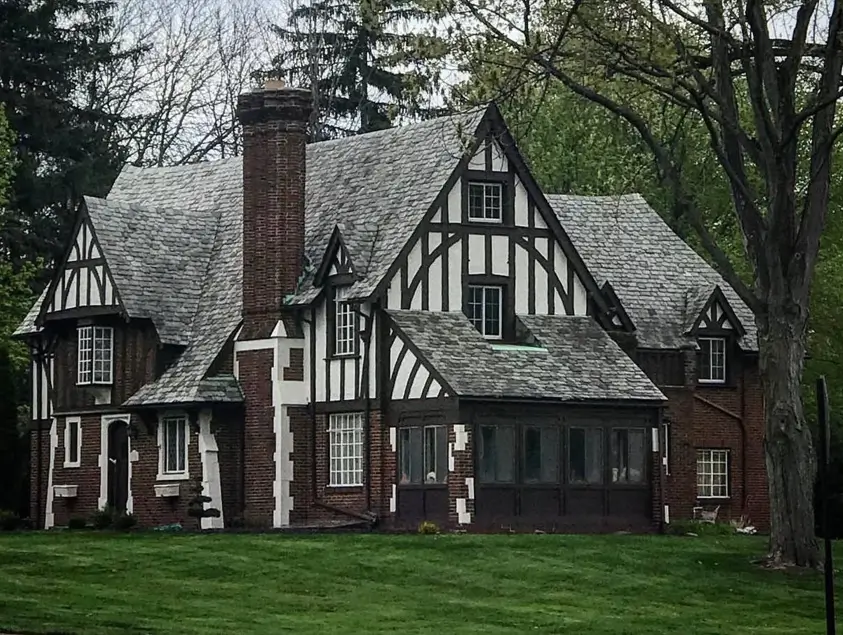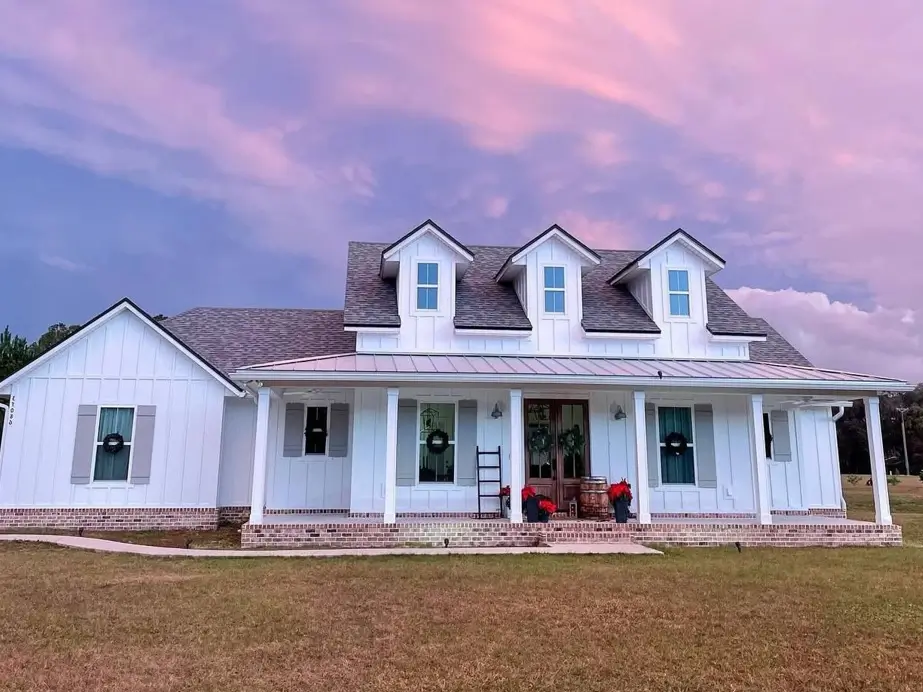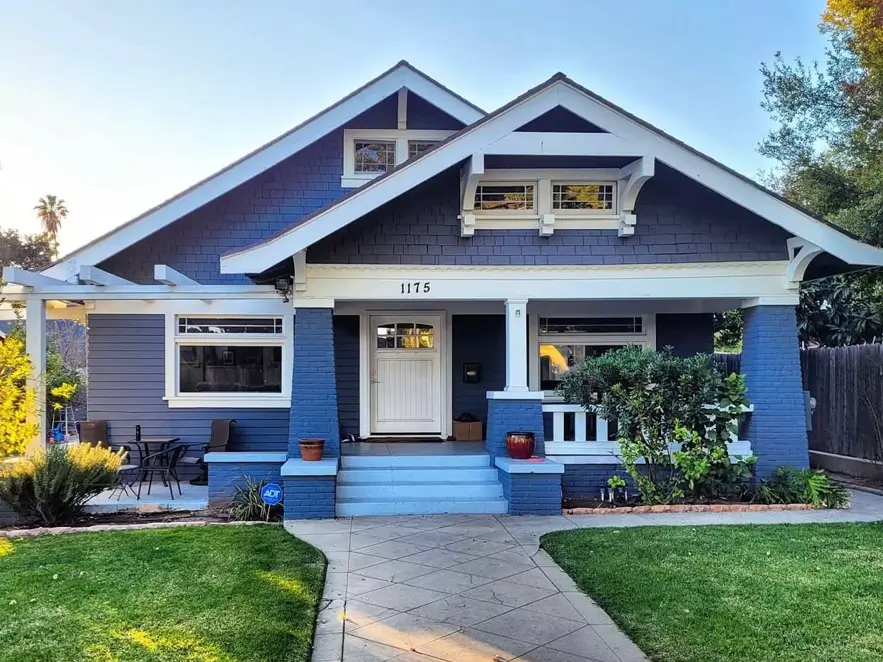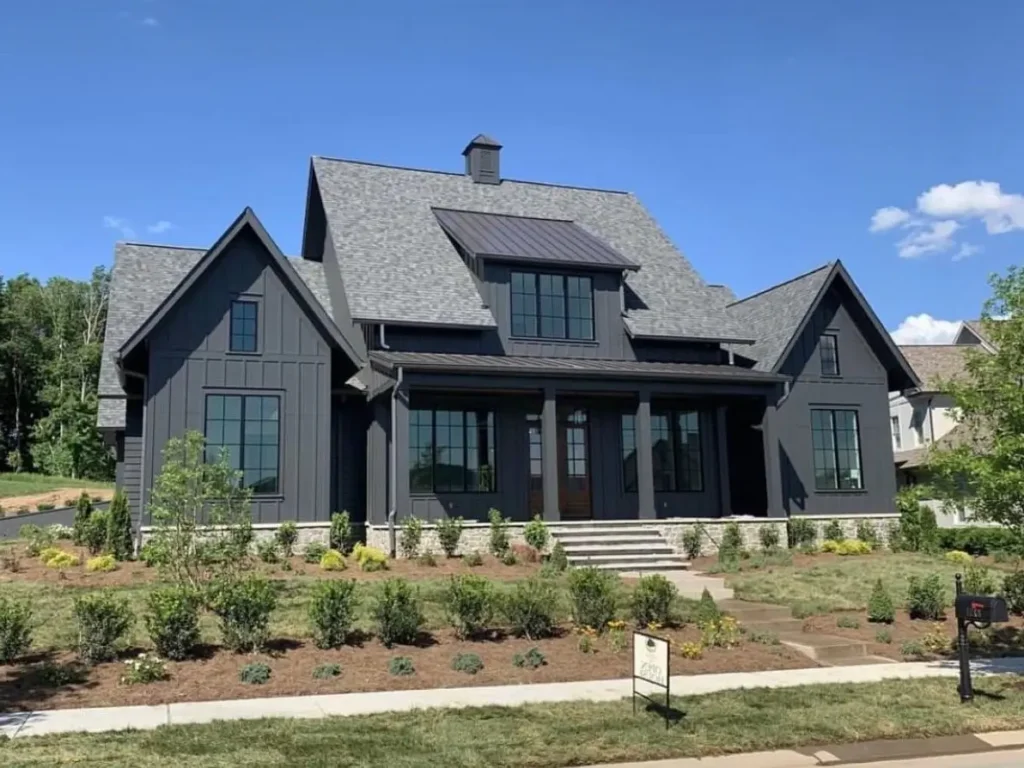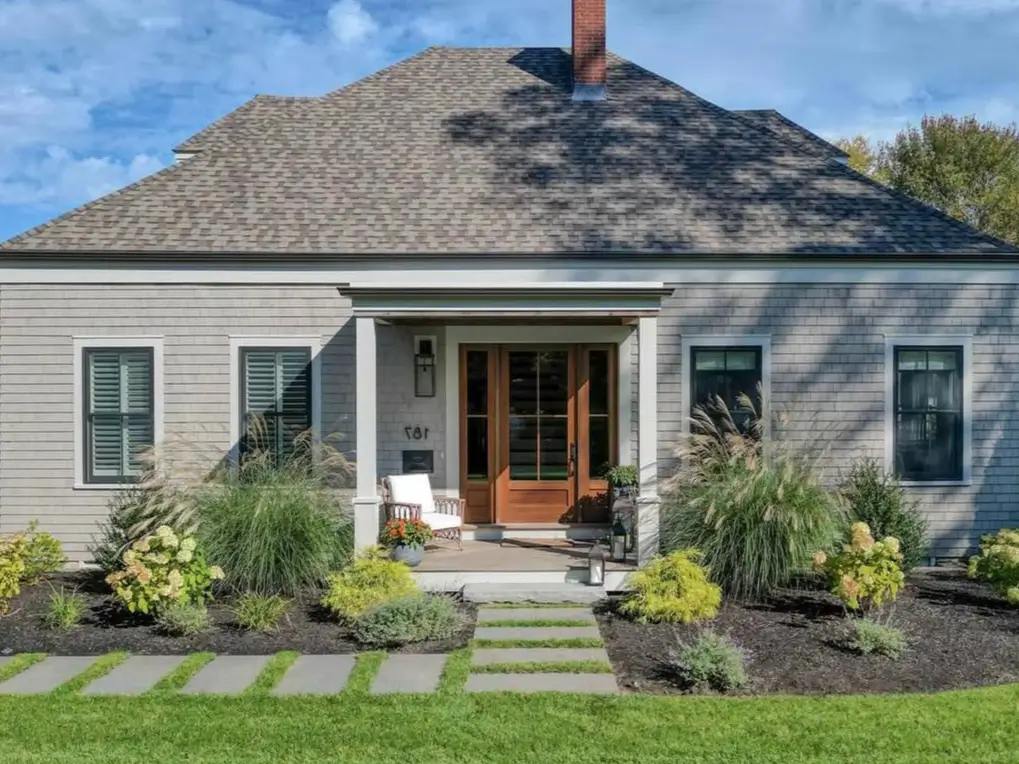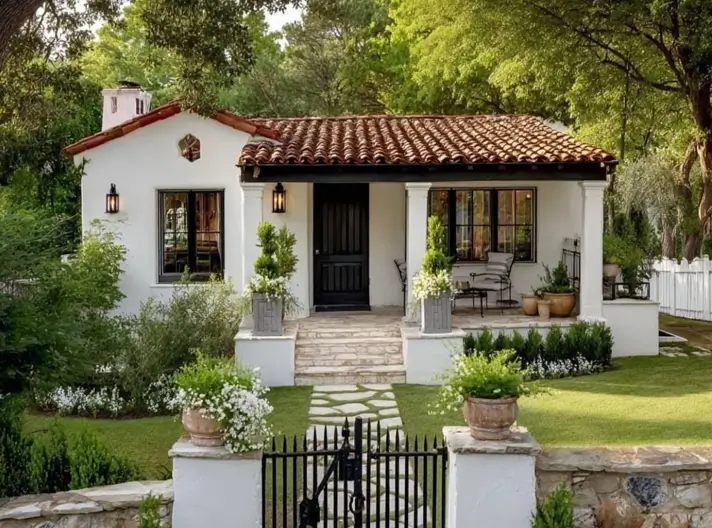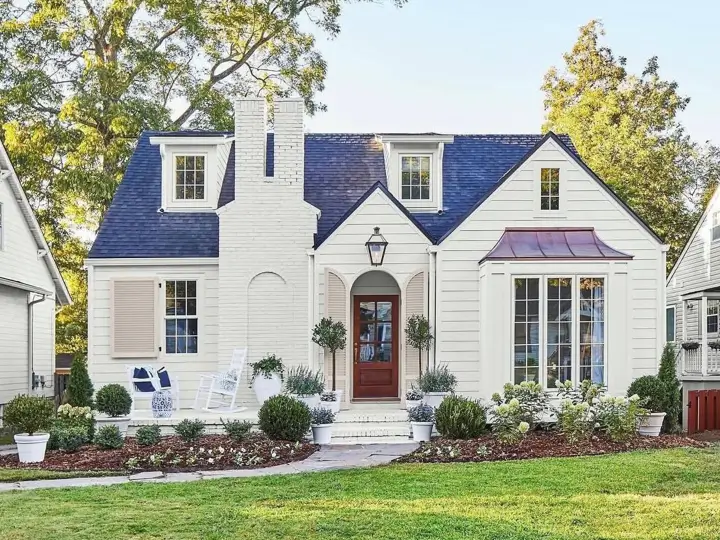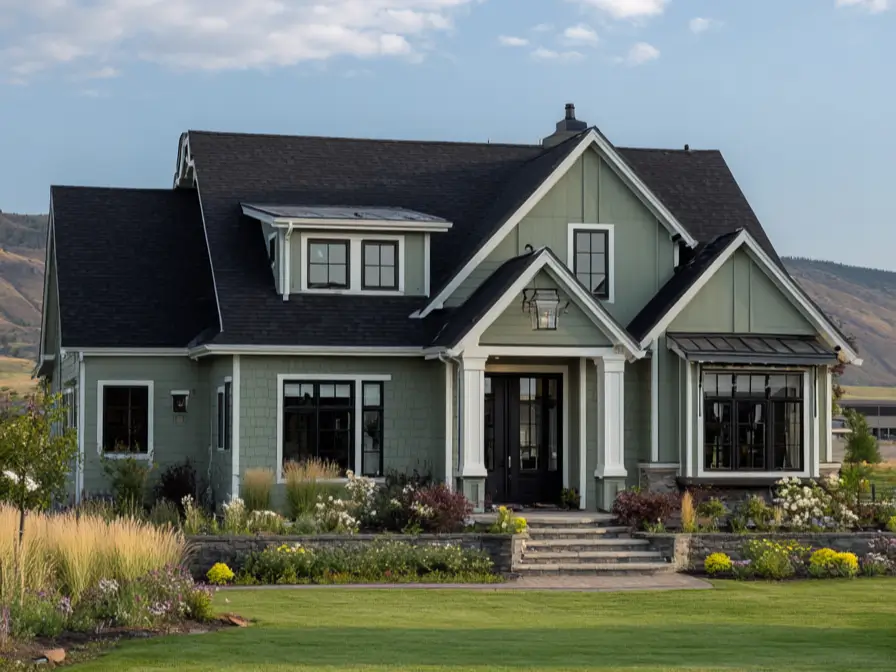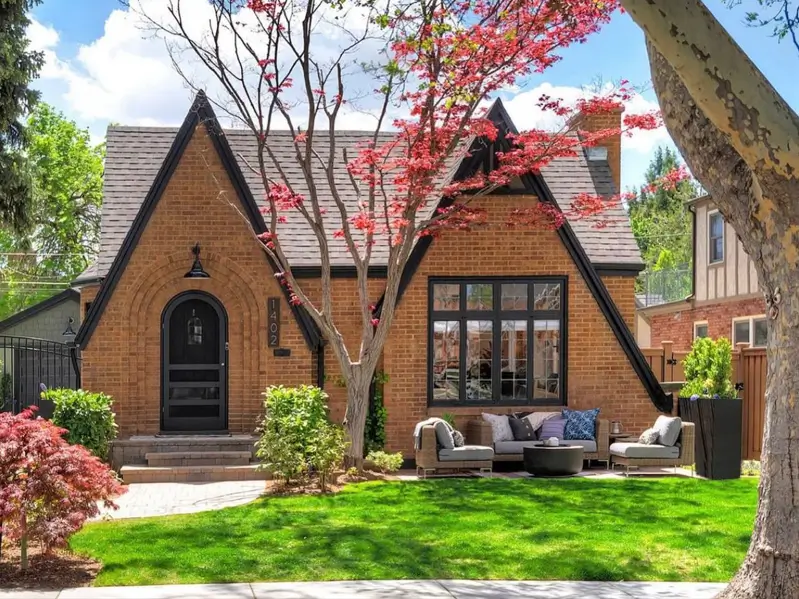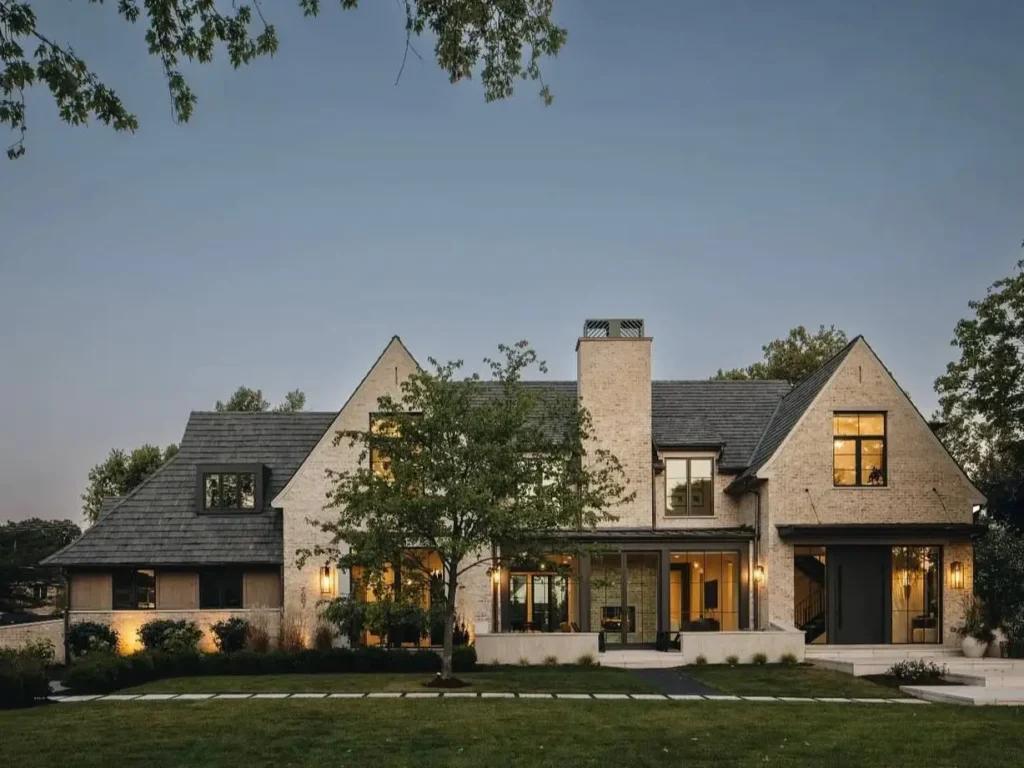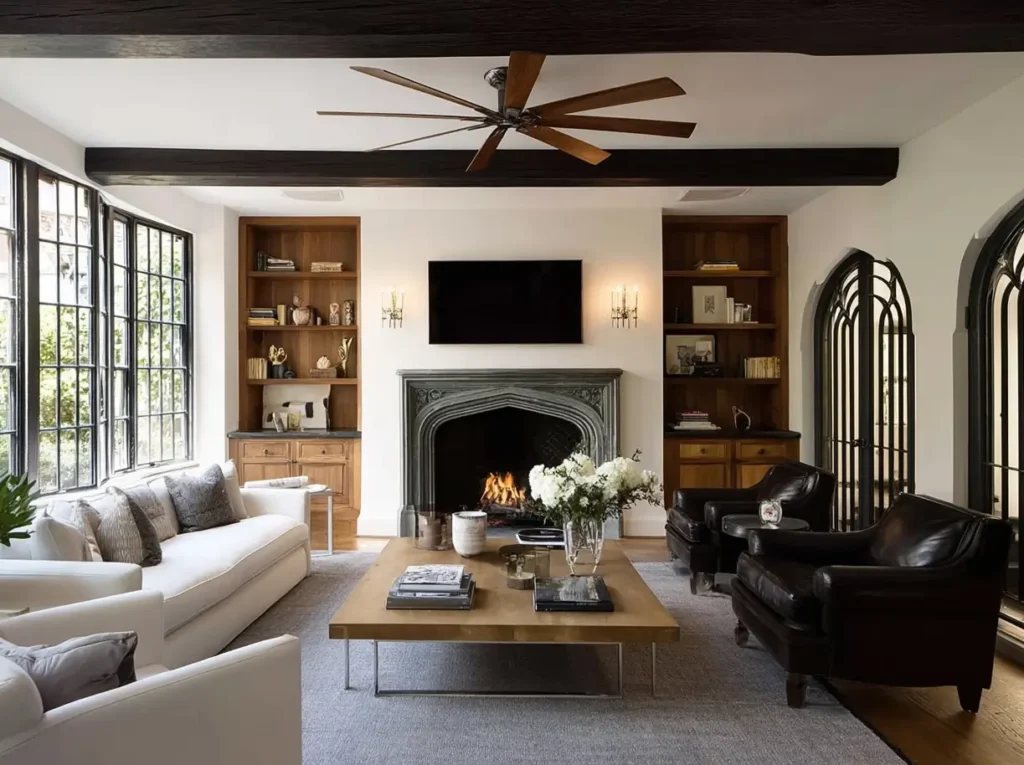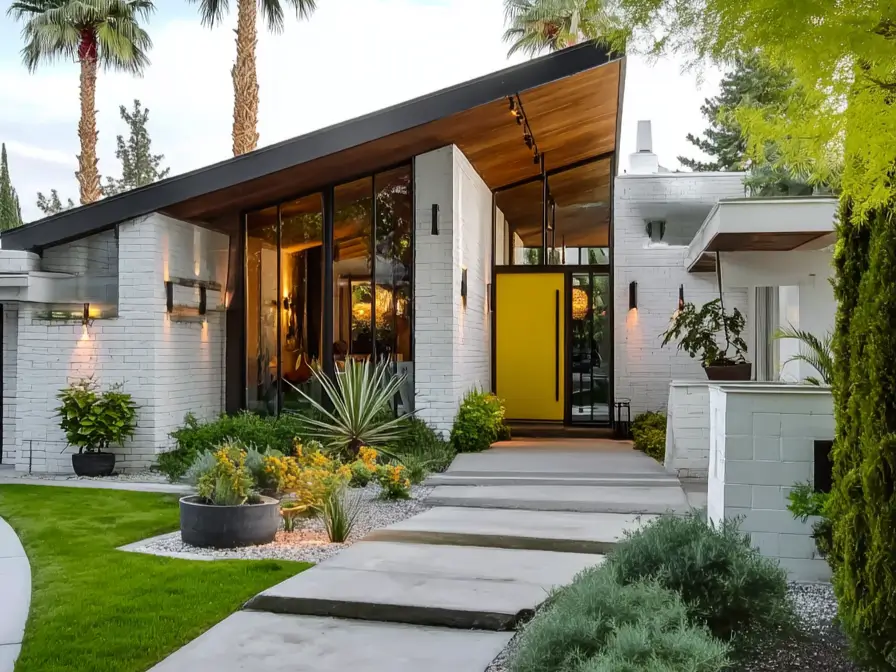Tudor-style house exterior charm is immediately recognizable, defined by a storybook collection of features like steeply pitched roofs, decorative half-timbering, and prominent chimneys. This enduring architectural form, rooted in Tudor Revival design, creates a fairy-tale impression that remains exceptionally popular today. Its blend of stately presence and rustic detailing offers a unique and timeless appeal.
While the classic look is beloved, many homeowners are now embracing the modern Tudor house exterior, a fresh interpretation that blends these historic details with clean lines and contemporary materials. The style’s inherent versatility allows for a wide range of expressions, from faithful historical reproductions to bold, contemporary statements that feel both fresh and rooted in tradition.
Whether your personal taste leans toward classic character or a fresh take on the modern Tudor-style house, the key is in the details. Ahead, you’ll find a curated collection of ideas covering classic architectural details, contemporary color schemes, rich material palettes, and the finishing landscaping touches that bring a Tudor facade to life.
Understanding the Key Characteristics of a Tudor-Style House
Before exploring visual inspiration, it helps to understand the foundational elements that define this beloved architectural style. A true Tudor-style house exterior is known for these classic features:
- Steeply Pitched Roof: A defining feature of Tudor Revival architecture, often with multiple, overlapping gables that create a dramatic, asymmetrical roofline.
- Decorative Half-Timbering: Exposed, non-structural wood beams set against a lighter stucco or stone background, creating the style’s signature decorative look.
- Prominent Chimneys: Substantial and often ornate, these chimneys frequently feature decorative brick or stone patterns and elaborate chimney pots.
- Leaded-Glass Windows: Tall, narrow windows are common, often arranged in groups and featuring multi-pane or decorative leaded-glass (diamond-pane) patterns.
- Arched Doorways: Sturdy, prominent entryways are a must, frequently made of wood and set within a rounded or Tudor-arched stone or brick surround.
Classic Tudor-Style House Exterior Ideas
These homes showcase the timeless and traditional elements of Tudor Revival architecture. This section provides Tudor facade inspiration rooted in rich textures and historical authenticity.
1. Ground with Natural Stone
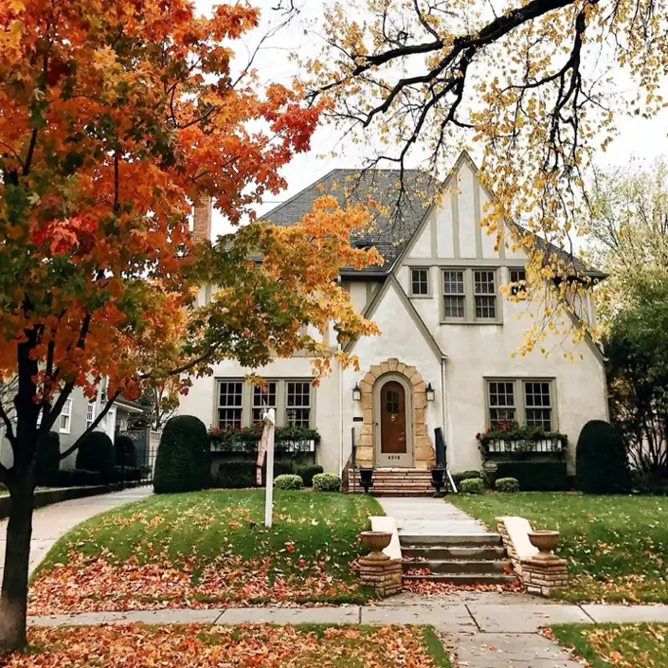
A stately stone archway lends permanence and grace to the entrance, creating an inviting focal point. Paired with classic stucco and dark timber accents on the gables, the composition feels both grand and welcoming—a hallmark of classic Tudor home design.
2. Add a Sweeping Roofline
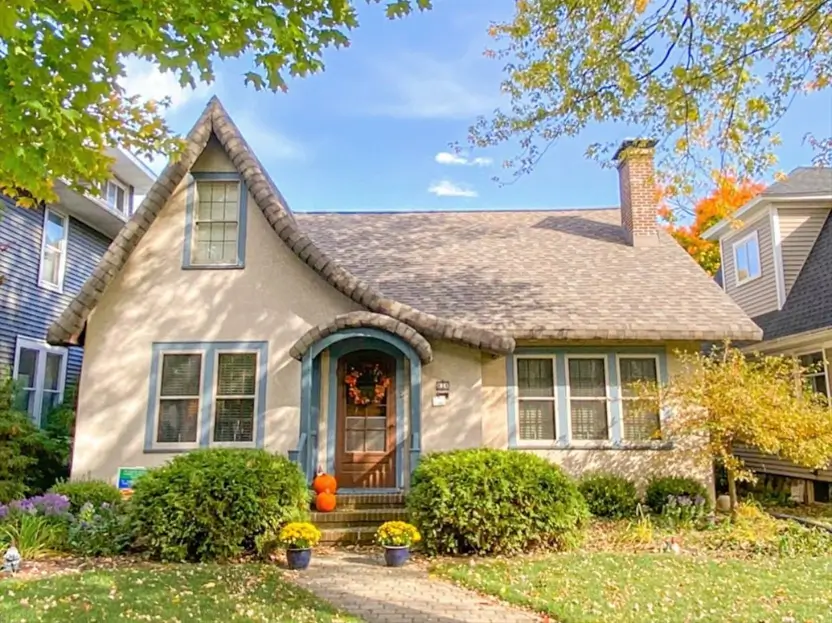
Few details evoke charm quite like a curved, sloping roof. This distinctive feature softens the home’s silhouette and creates a cozy, sheltered entryway. A gentle blue trim offers a bespoke touch, highlighting the windows and door against the warm, textured stucco walls.
3. Layer Rich Materials
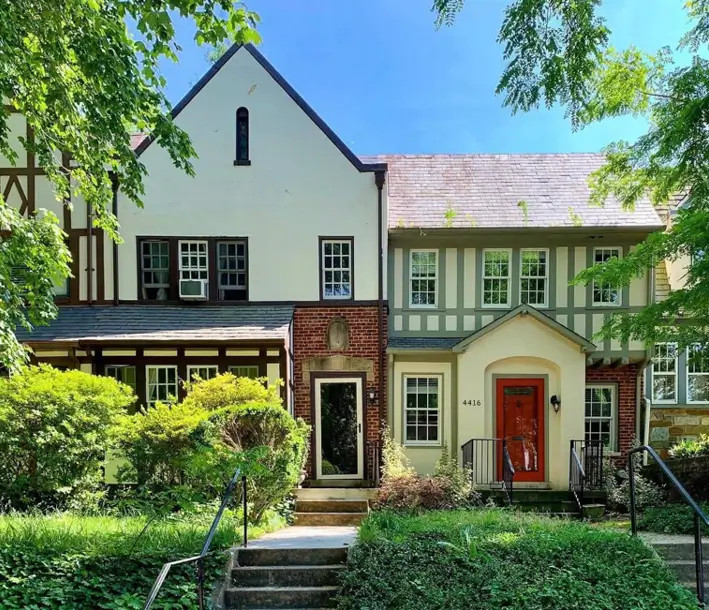
One of the hallmarks of Tudor design is its rich, layered use of materials. Here, a sturdy brick base grounds the home, giving way to classic stucco and timber details above. This thoughtful combination creates a Tudor-style house exterior with significant visual weight.
4. Showcase Intricate Details
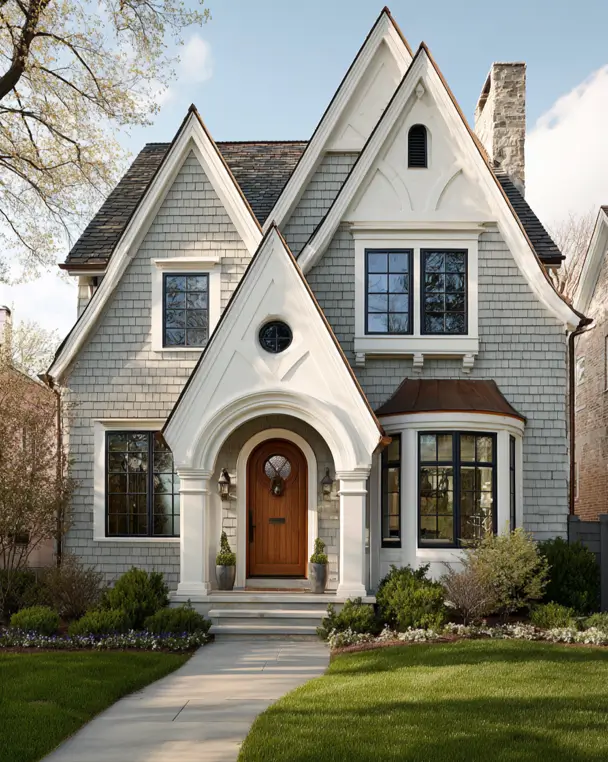
Crisp white trim beautifully outlines the home’s complex gables and arched portico, creating a sophisticated silhouette. Paired with soft gray shingles and a warm wood door, the facade feels layered and elegant. This approach proves that intricate millwork can define the style, even without traditional half-timbering.
5. Use Vertical Lines
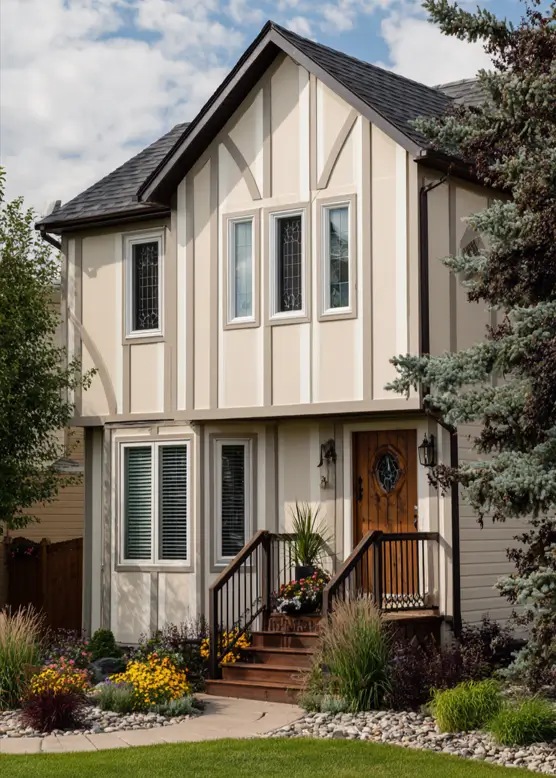
Employing strong vertical lines in the timbering can visually stretch the facade, lending a sense of height and grandeur. This is an effective technique for narrower homes, making them feel more stately. A warm, neutral color palette unifies the exterior, allowing the detailed front door to stand out.
6. Add Ornate Half-Timbers
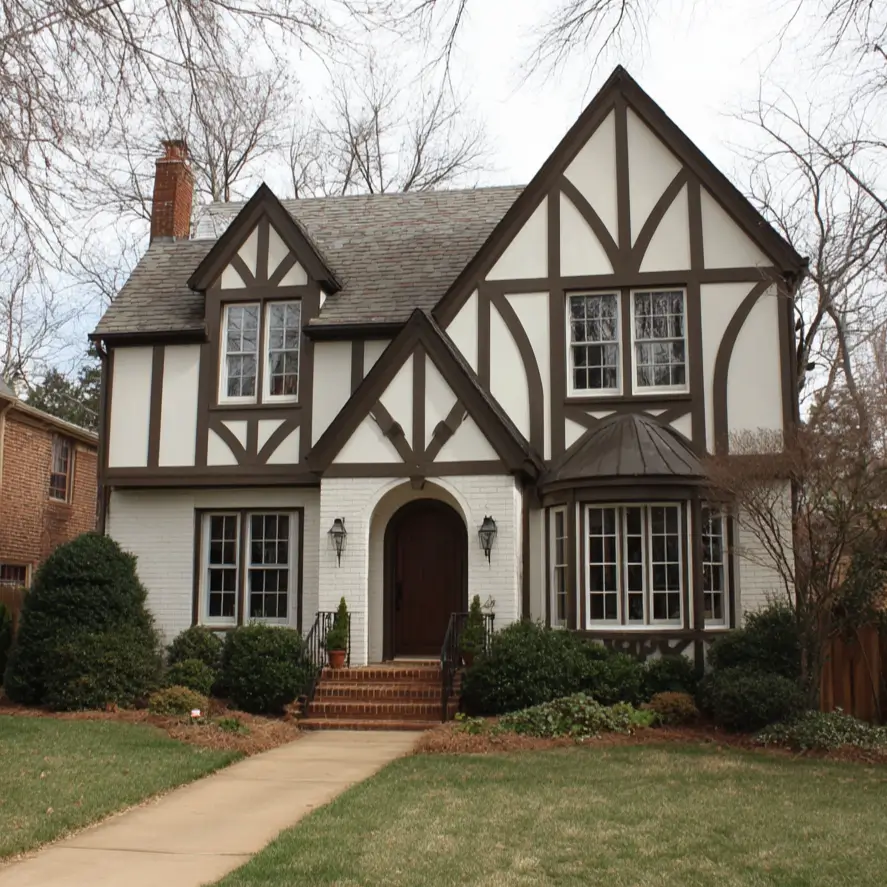
The hallmark of this style is often its ornate half-timbering, which creates captivating patterns across the gables. Here, dark, curved timbers against light stucco define the home’s character and architectural heritage, essential for an authentic storybook presentation.
7. Channel Medieval Charm
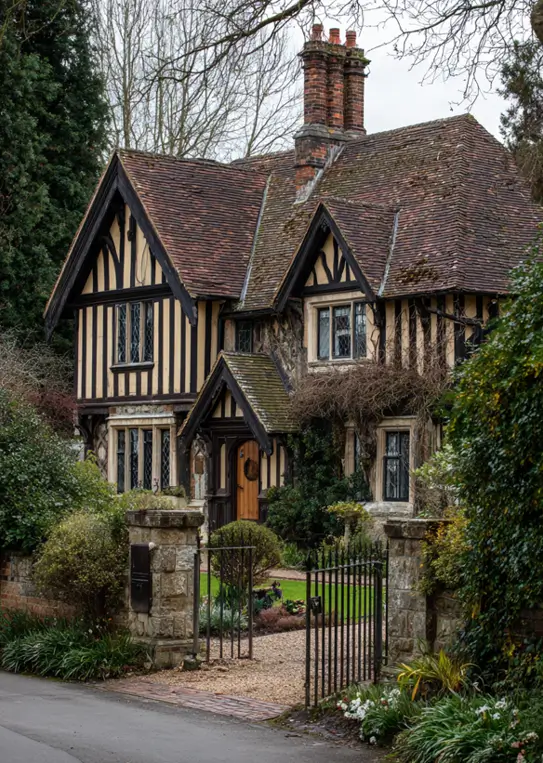
True historic character radiates from a home with dense timbering and a traditional clay tile roof. The varied rooflines and weathered textures create an authentic medieval quality, transporting the structure to another time and place through its traditional craftsmanship.
8. Create a Storybook Cottage
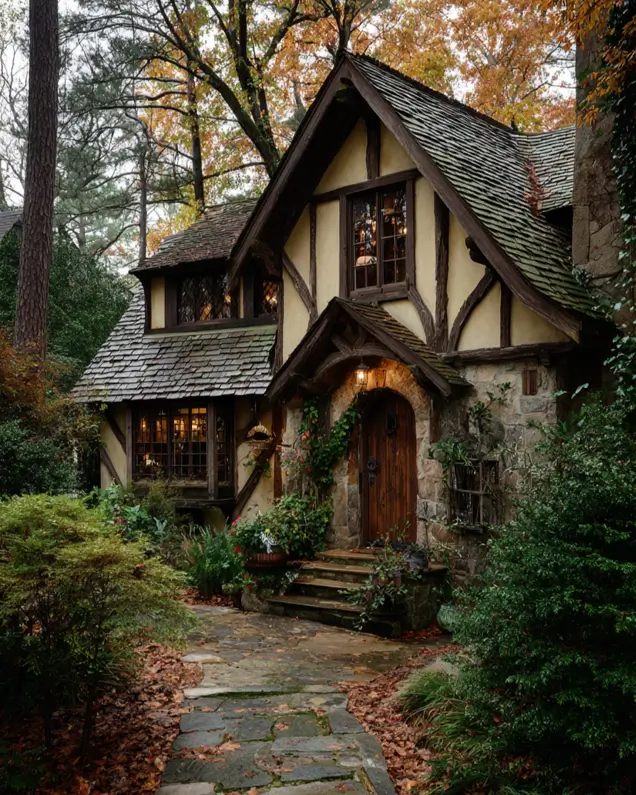
Irregular rooflines and a rustic stone base establish this home’s fairytale character, creating true storybook cottage charm. This approach to the Tudor-style house exterior results in a warm, inviting glow that feels perfectly nestled within its natural, forested environment.
9. Use Diamond-Pane Windows
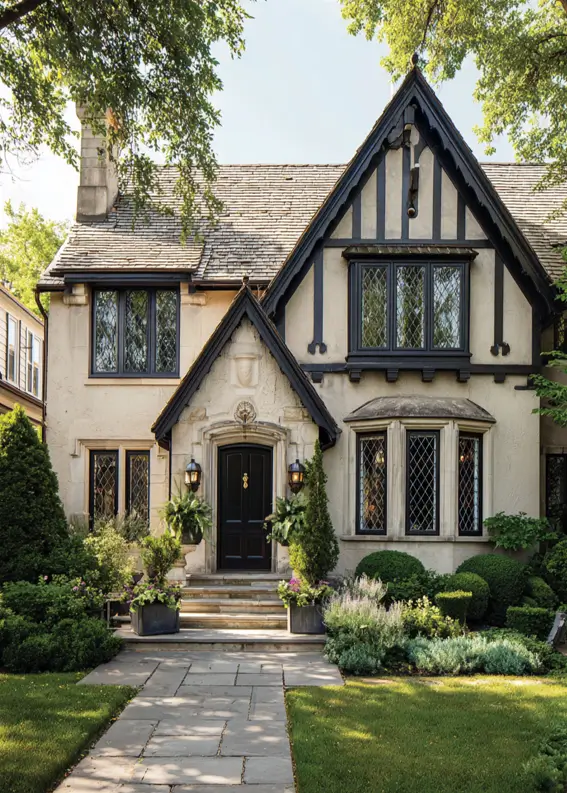
Diamond-pane windows lend an air of authenticity and intricate detail to the facade. Paired with a carved stone entryway and dark, dramatic timbering, these windows enhance the home’s historic character and create an elegant exterior that feels both grand and established.
10. Incorporate a Slate Roof
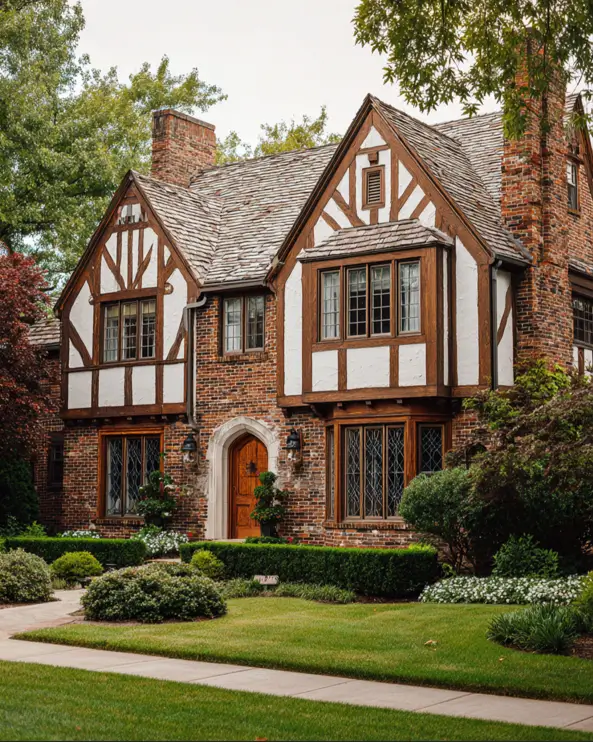
Slate roofing offers timeless durability and textural beauty that perfectly complements the Tudor-style. Its natural variations add a layer of rustic elegance to the home’s warm brick and classic timber details, creating a look of substance and permanence.
11. Design a Grand Estate
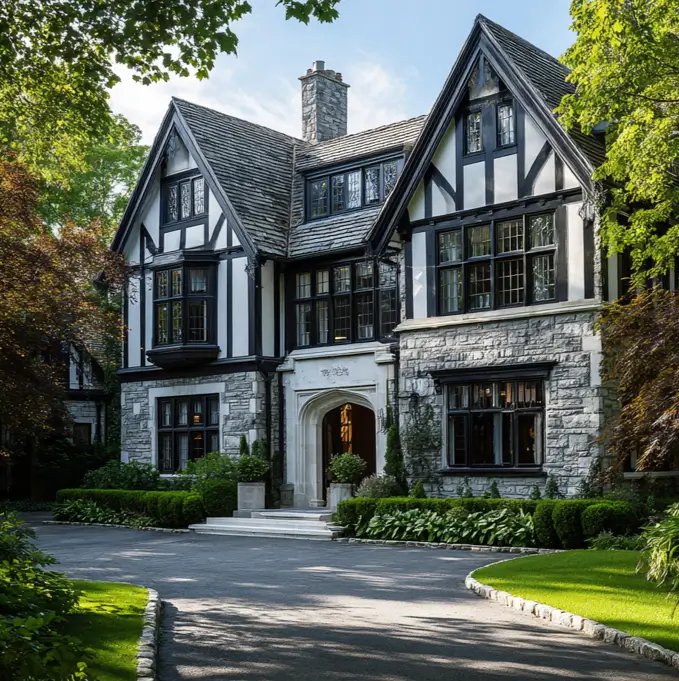
Rough-hewn stone creates a commanding presence for the home’s lower level, providing a textural counterpoint to the crisp half-timbering above. The sweeping driveway and meticulous landscaping complement the grand scale, establishing an impressive estate.
12. Feature an Oriel Window
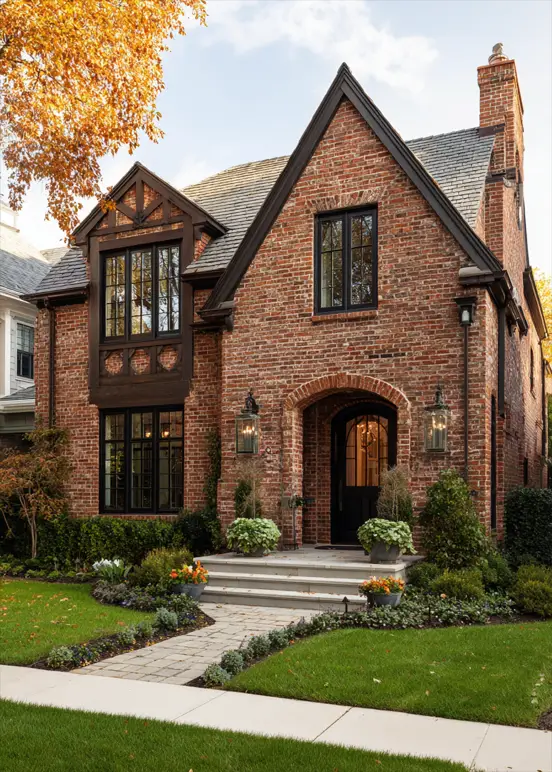
Projecting oriel windows create a beautiful architectural feature, adding dimension and historical character. Here, the dark woodwork of the window provides a striking contrast against the warm, textured brick, creating a detailed focal point on the Tudor facade.
Ideas for a Modern Tudor House Exterior
A fresh take on a classic, the modern Tudor house exterior simplifies forms and heightens contrast. These curb appeal ideas embrace a sophisticated, contemporary palette, often featuring black windows for a truly updated look.
13. Use a High-Contrast Palette
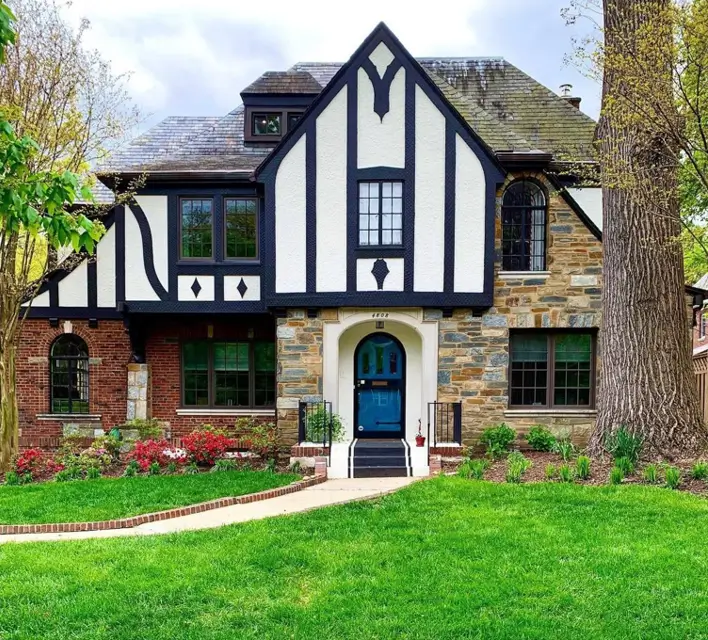
Crisp white stucco and bold, black timbering create a graphic statement that feels both timeless and contemporary. This modern Tudor house exterior confidently balances the striking pattern with natural stone and warm brick, while a vibrant blue door injects personality.
14. Select a Gray Trim
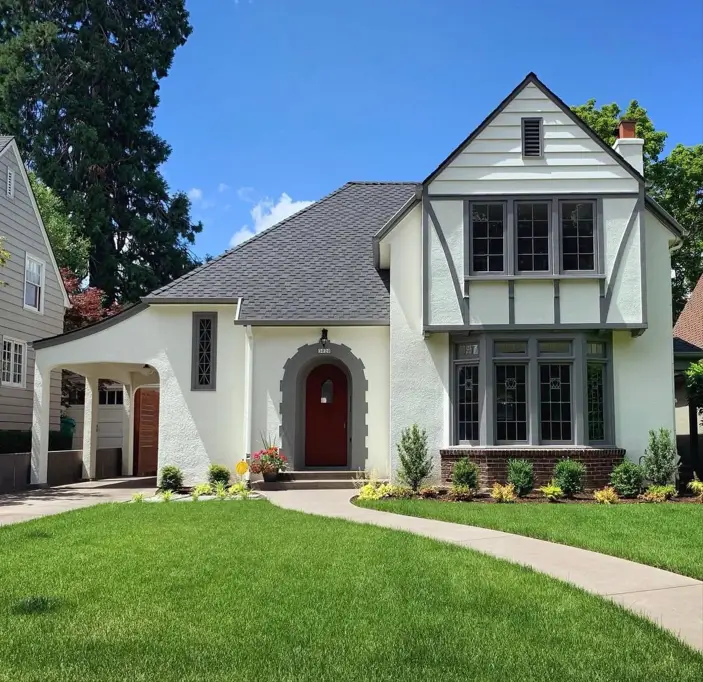
A shift to a sophisticated gray for the trim and timbers offers a subtle, contemporary update. This choice harmonizes beautifully with a dark roof and crisp white stucco, allowing a single, bold color—like a rich red door—to truly stand out as a focal point.
15. Balance Lines and Textures
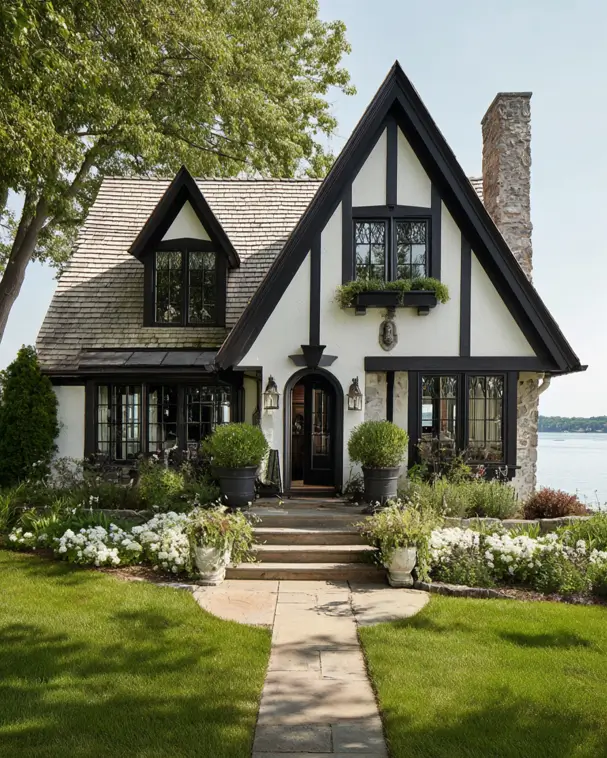
This lakeside home strikes a beautiful balance between bold design and organic materials. The sharp, graphic quality of the black and white timbering is softened by the natural texture of a cedar shake roof and a substantial stone chimney, integrating the structure harmoniously into its scenic surroundings.
16. Use Dramatic Black Accents
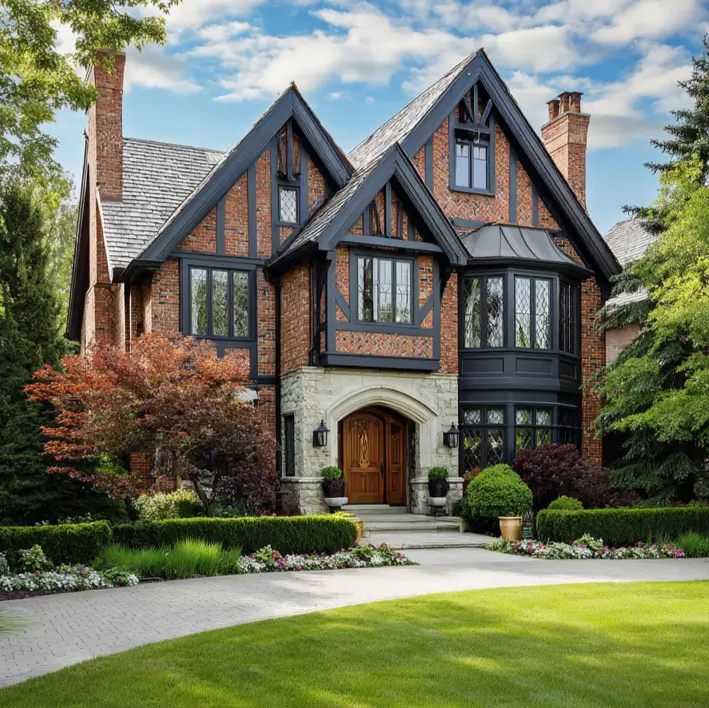
Deep black trim provides a striking, contemporary contrast against classic red brick. This bold palette gives the traditional Tudor form a modern edge, while a pale stone entryway offers a sophisticated point of welcome, creating a standout modern Tudor-style house.
17. Embrace Complex Gables
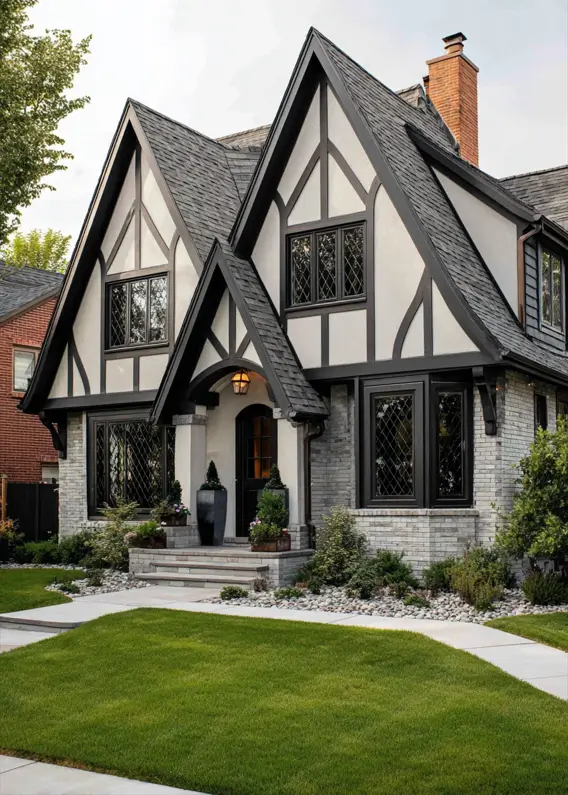
Overlapping gables create a dynamic and complex roofline, adding significant architectural interest. The sturdy stone base provides a textural contrast to the crisp, graphic half-timbering above, resulting in a facade that feels both layered and thoroughly modern in its execution.
18. Darken the Upper Level
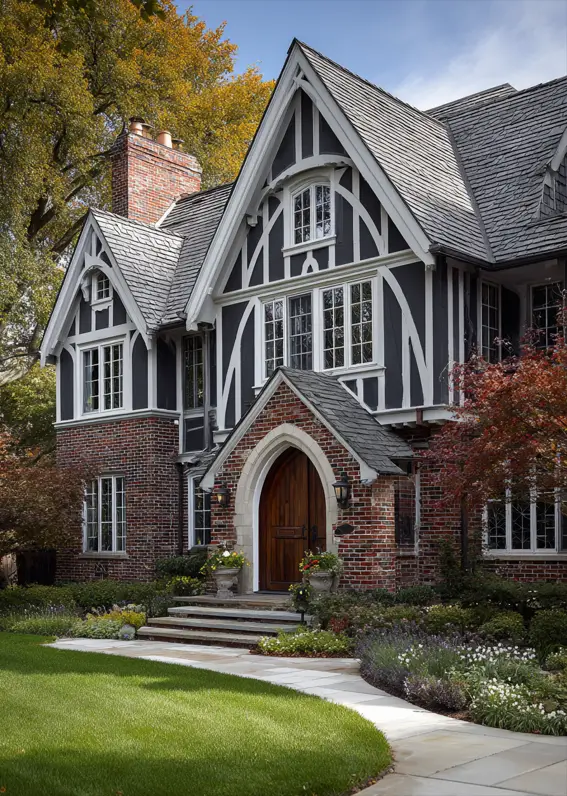
Dark siding on the upper level offers a dramatic counterpoint to the traditional red brick below. White timbers create a sharp, graphic pattern, giving this modern Tudor house exterior a bold, contemporary attitude while honoring its classic architectural roots.
19. Try a Monochromatic Look
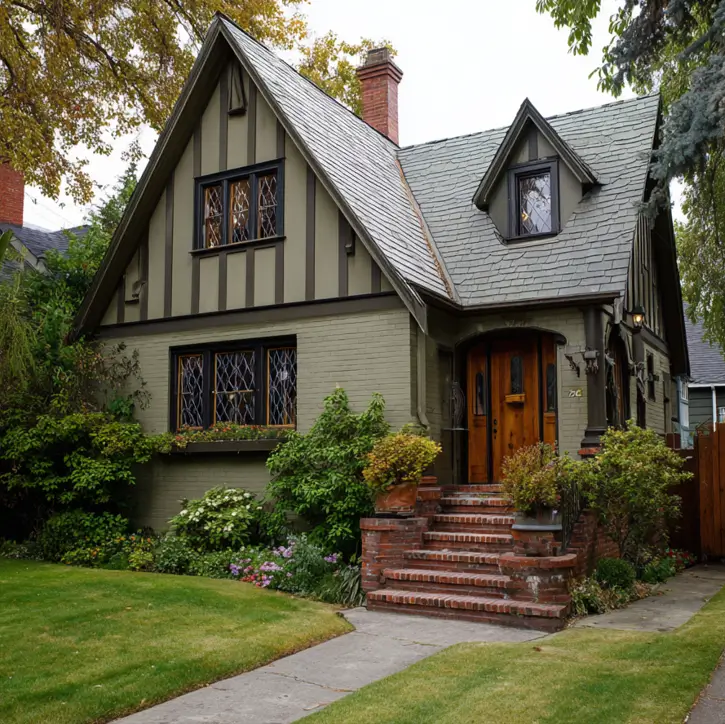
Deep, earthy green envelops this home, unifying the brick and timber details under a single, sophisticated hue. This monochromatic approach allows the architectural forms to create interest through shadow and light, resulting in a cohesive and modern look.
20. Embrace a Moody Aesthetic
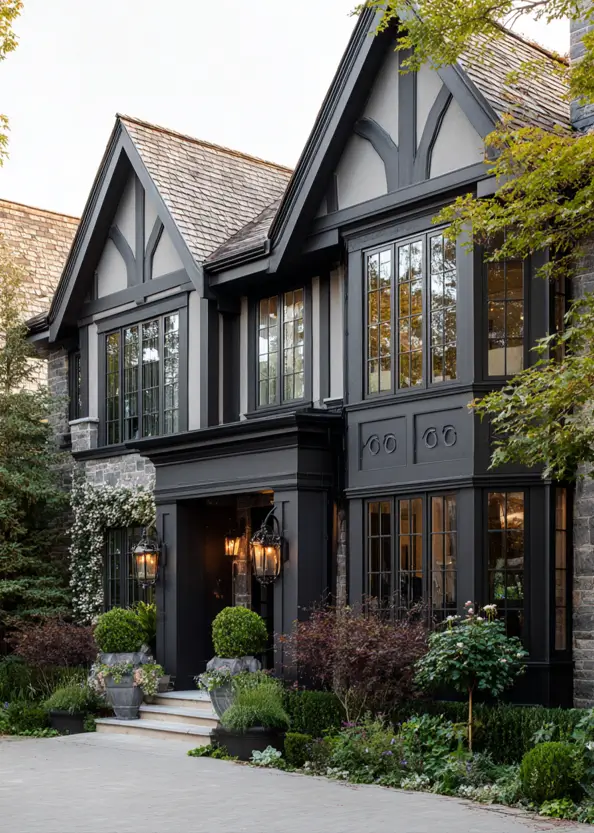
Deep charcoal and black tones lend this home a sophisticated, moody presence. The aesthetic borrows from the popular modern Tudor farmhouse trend, with a grand portico, dark windows, and lighter gables that contrast with the cool-toned stonework.
21. Choose Cool Stone
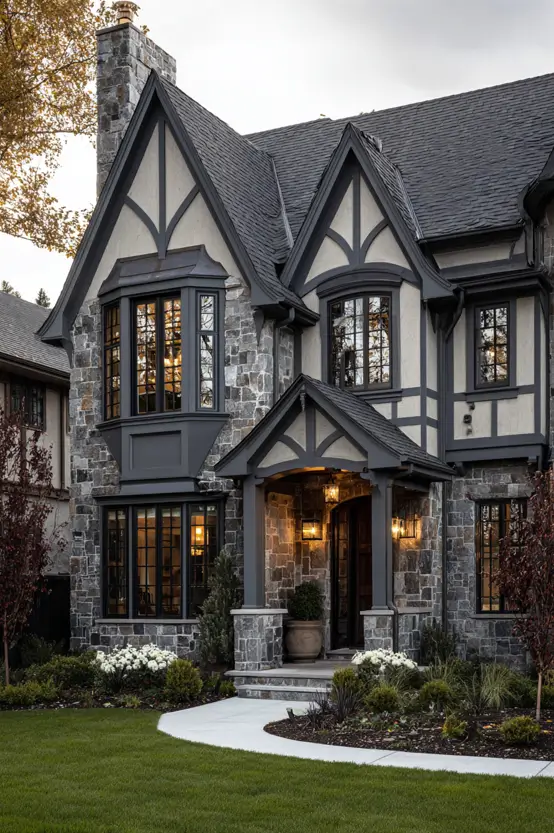
Cool-toned stone provides a modern, textural backdrop for this sophisticated facade. The deep charcoal trim and half-timbering create a clean, graphic contrast. This palette gives the modern Tudor house exterior a stately, contemporary presence.
Exterior Material & Color Palettes for Tudor-Style Homes
Choosing the right exterior color schemes and materials is central to achieving a cohesive look. While classic brick and stone offer timeless durability, modern composites can replicate the half-timbered look with less maintenance. Your choice for an exterior renovation may depend on climate, budget, and the desired level of historical authenticity.
22. Soften with Lighter Trim
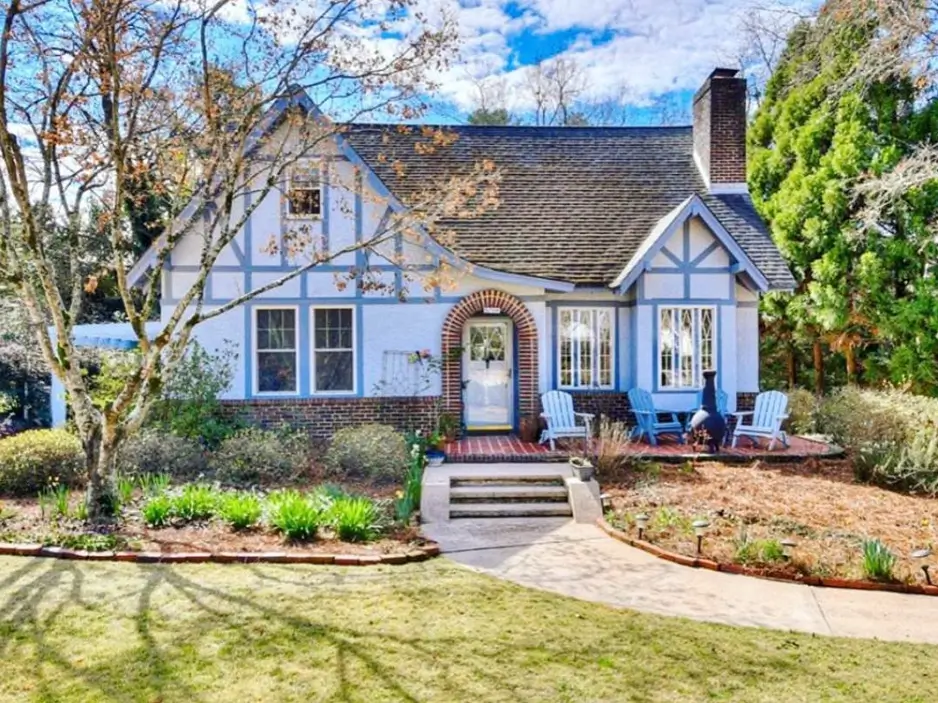
Departing from traditional dark brown, a lighter trim color can infuse a Tudor-style exterior with a softer charm. Here, a dusty blue hue accentuates the half-timbering, beautifully complementing the brickwork and creating a welcoming, cottage-like atmosphere.
23. Use a Tonal Palette
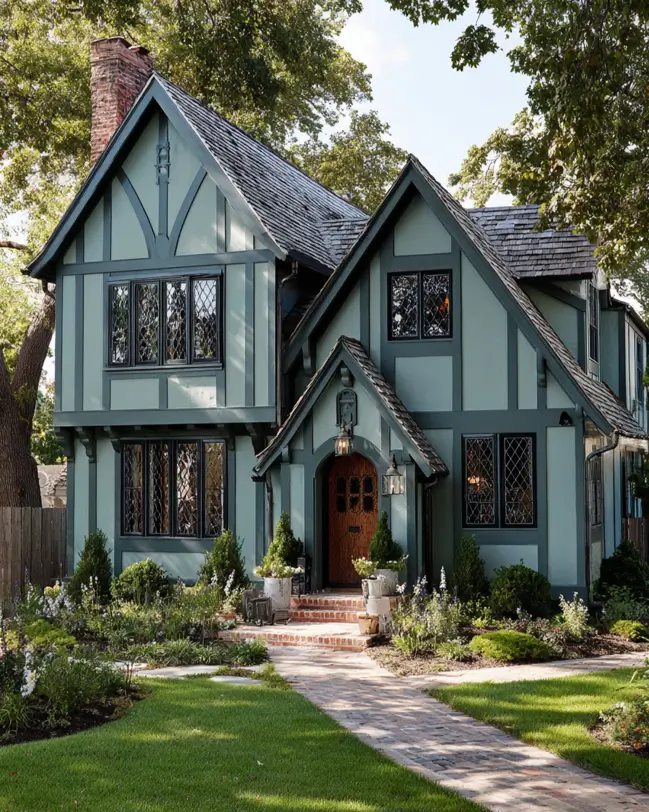
Painting the stucco and timbering in similar deep, moody tones creates a sophisticated, unified facade. This tonal approach allows the intricate windows and the warm wood of the front door to become quiet, elegant focal points, blending the home into its surroundings.
24. Add Warm Cedar Shingles
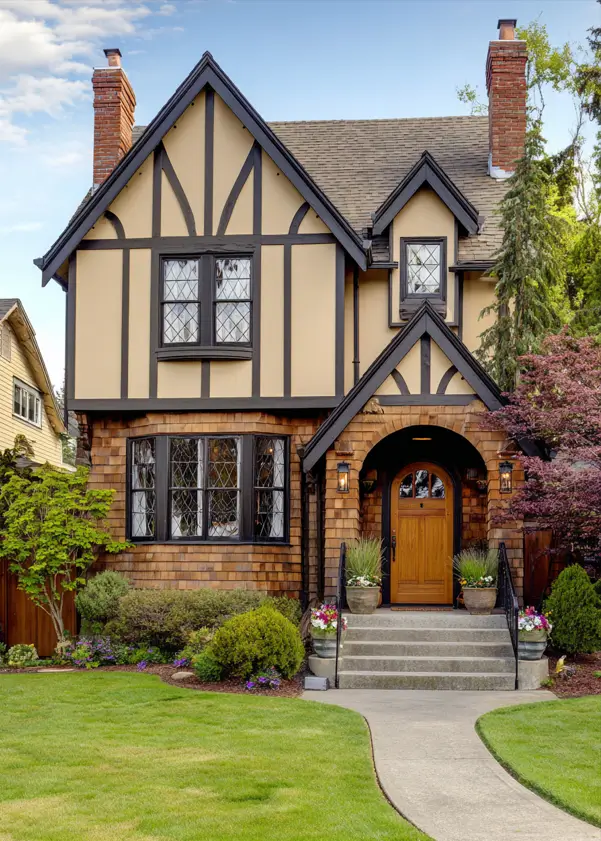
Wood shingles on the lower level introduce a rich, warm texture that beautifully complements the stucco and dark timbering above. This layered approach adds depth and a sense of craftsmanship to the exterior, creating a cohesive and welcoming Tudor facade.
25. Feature a Brick Facade
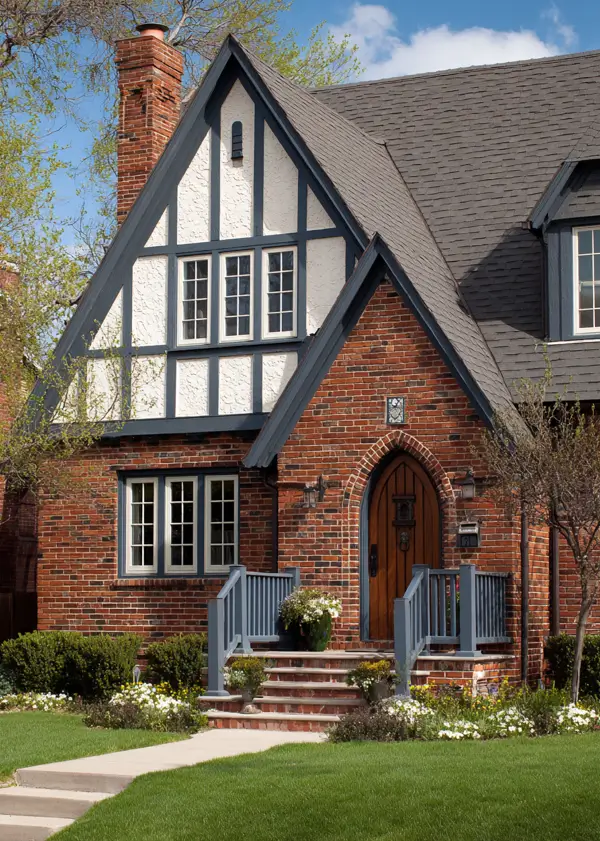
A facade built primarily from brick lends a sense of permanence and history. The material’s inherent texture provides a rich backdrop for classic details, creating a Tudor-style house exterior with enduring substance.
26. Highlight the Stone Entry
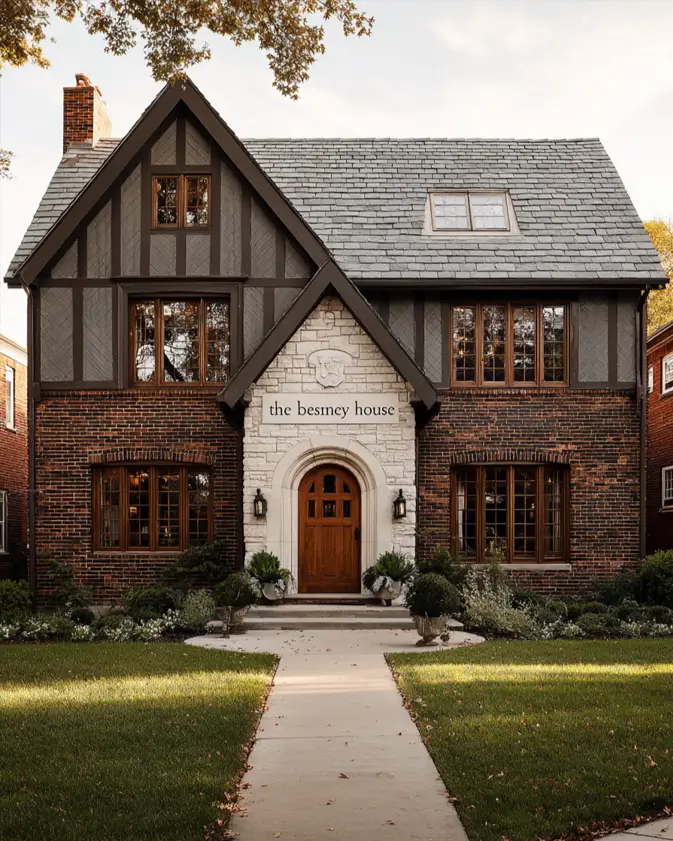
Light stone makes a brilliant statement when used for a grand entryway against a darker home. The contrast between the pale stone and rich brickwork creates a sophisticated focal point, giving this modern Tudor-style house a truly commanding presence.
27. Harmonize Mixed Materials
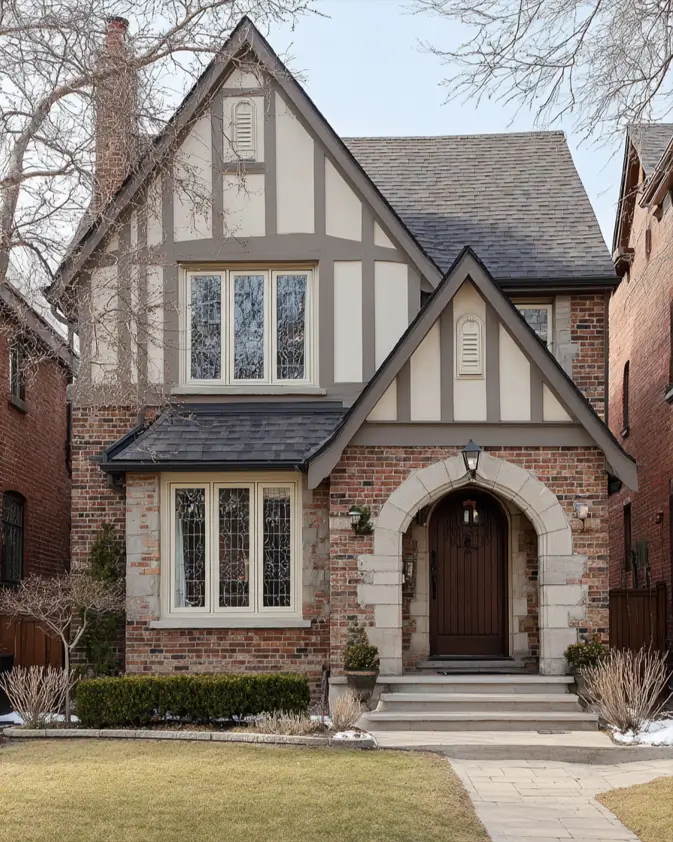
Thoughtful composition allows varied materials to work in concert. This home’s brick base and stone archway provide a sturdy, textured foundation, while the lighter stucco and timbering on the upper level add classic decorative detail to the exterior design.
28. Mix in Modern Siding
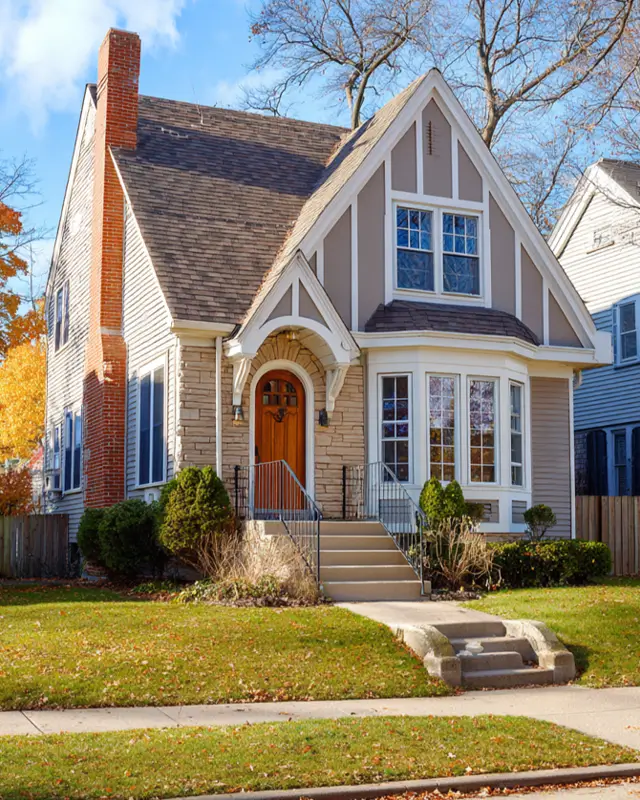
Horizontal siding offers a fresh and approachable alternative to traditional stucco. This home successfully integrates it with signature Tudor elements, including a stone-clad entryway, a steep front gable, and an inviting bay window, creating a look that feels both familiar and custom.
29. Paint the Brick Exterior
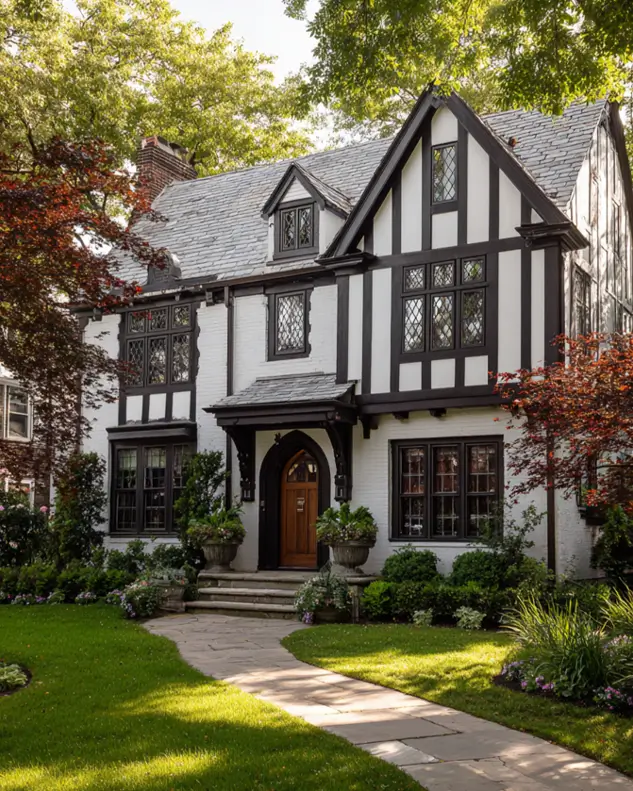
White-painted brick offers a fresh take on a traditional material, creating a clean and unified base. This bright facade beautifully accentuates the dark, graphic timbering and detailed windows, allowing the home’s strong architectural lines to take center stage. Consider learning more about how to paint the brick exterior for a lasting finish.
30. Use a Brick Foundation
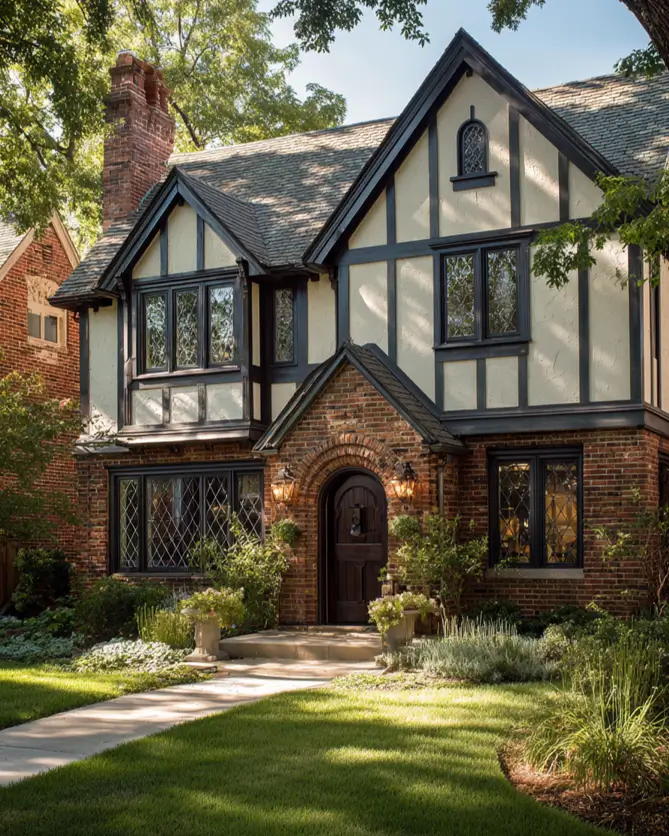
Rich brickwork on the lower level provides a sense of history and permanence. This classic foundation beautifully grounds the lighter stucco and dark timbering of the upper story, creating a facade with balanced proportions and enduring character.
31. Use an Earthy Palette
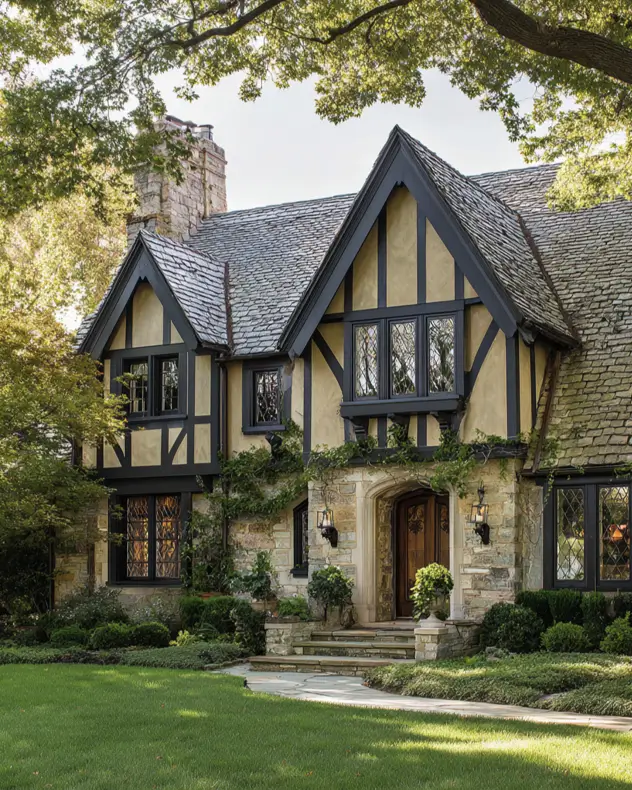
Warm beige stucco and dark, earthy trim create a cohesive and inviting palette. This combination beautifully complements the natural stone entryway and slate roof, resulting in a sophisticated facade that feels both grand in scale and perfectly harmonized with its lush, mature landscape.
32. Use a Bold Color
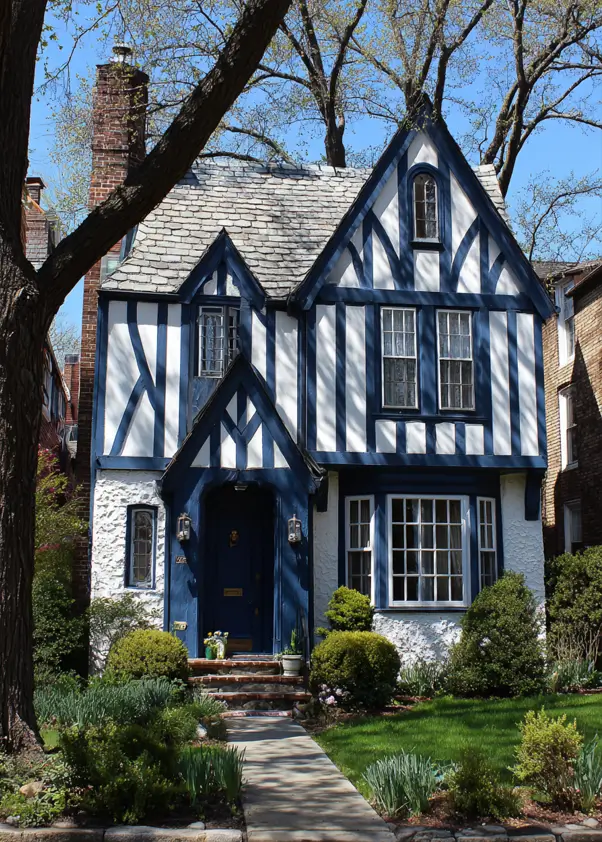
Deep blue paint makes a dramatic and personal statement across the entire facade. Applying a single, saturated color to the timbering and front door creates a cohesive, graphic look that instantly updates the home’s traditional form with confidence.
33. Create a Lodge Aesthetic
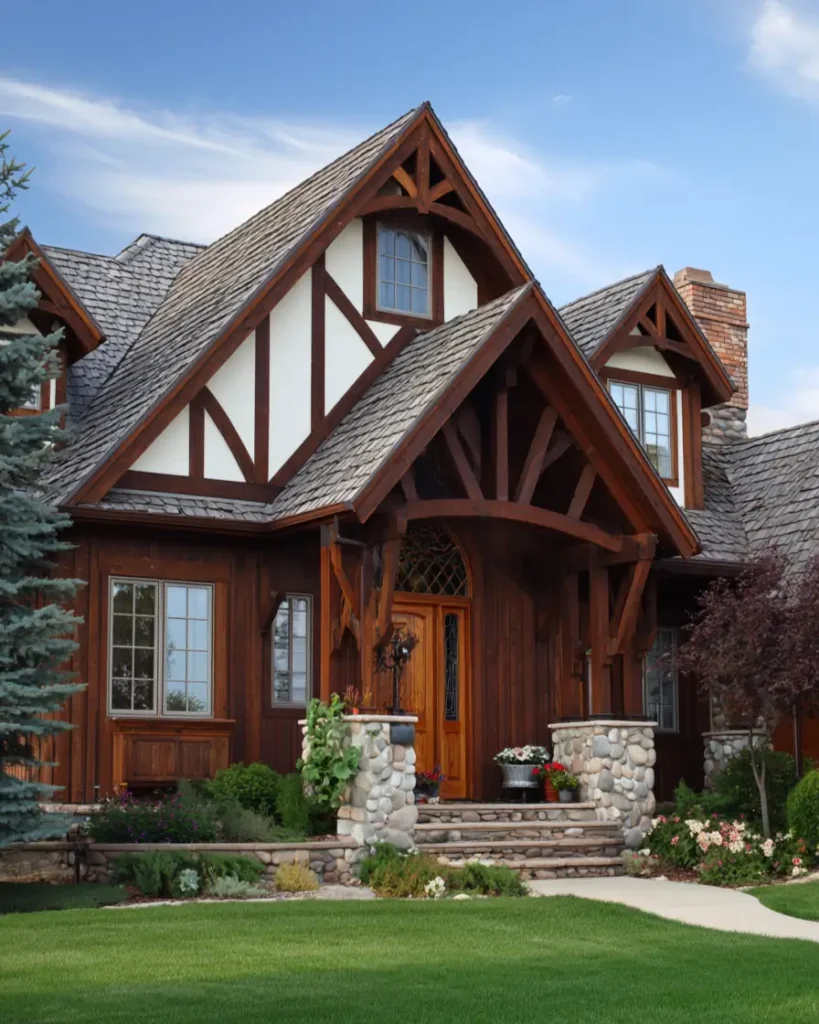
Exposed timber framing on the portico and gables creates a rustic, lodge-inspired feel, perfect for a mountain setting or a major exterior renovation. Paired with warm wood siding and a sturdy river-rock base, the home exudes a cozy, handcrafted charm.
Finishing Touches for Your Tudor-Style House Exterior
The right architectural details and landscaping are essential for perfecting curb appeal. These finishing touches, from garden design to window accents, are key for creating an inviting first impression.
34. Soften with Greenery
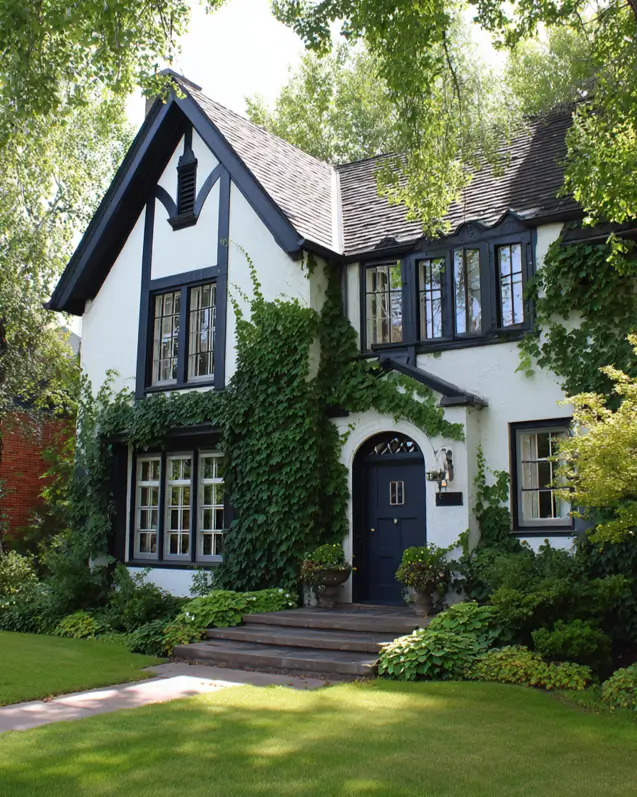
Climbing ivy introduces a romantic, living element that softens the crisp architectural lines. The lush greenery provides a beautiful textural contrast against the stucco and dark timbers, creating a sense of timelessness and integrating the home with its landscape.
35. Infuse Provincial Charm
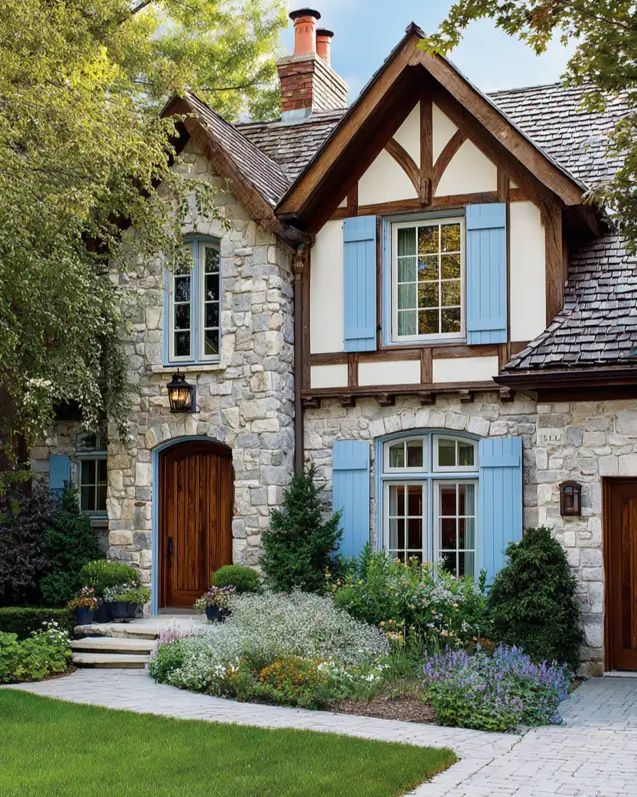
Shutters painted in a cheerful, provincial blue provide a delightful counterpoint to the home’s rustic stone exterior. This unexpected touch of color softens the traditional Tudor architecture, infusing it with a sense of European countryside charm.
36. Guide with a Flagstone Path
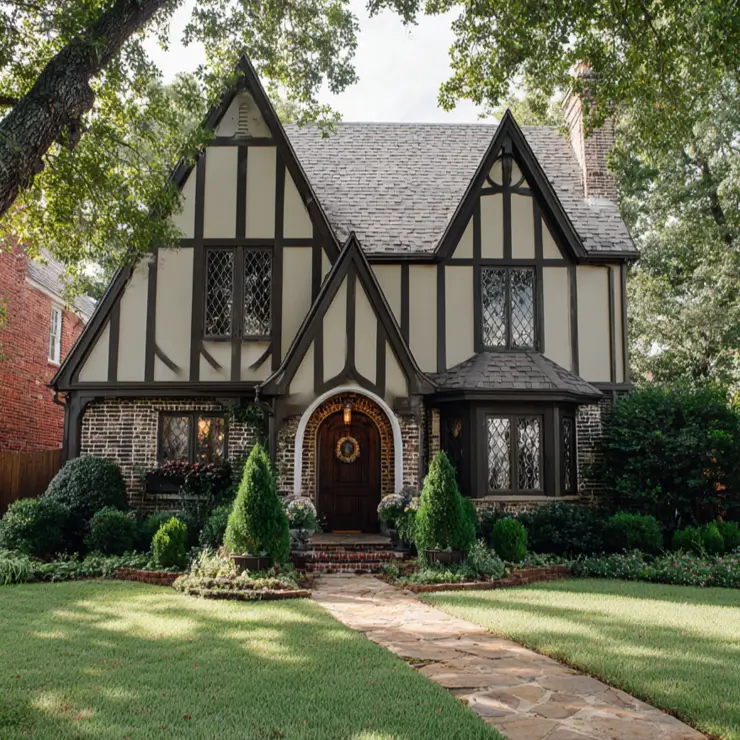
Curving flagstone paths create a graceful approach, softening the strong geometry of a traditional facade. This organic walkway guides the eye through the manicured landscape toward the arched brick entryway, enhancing the home’s stately character.
37. Create a Sheltered Entry
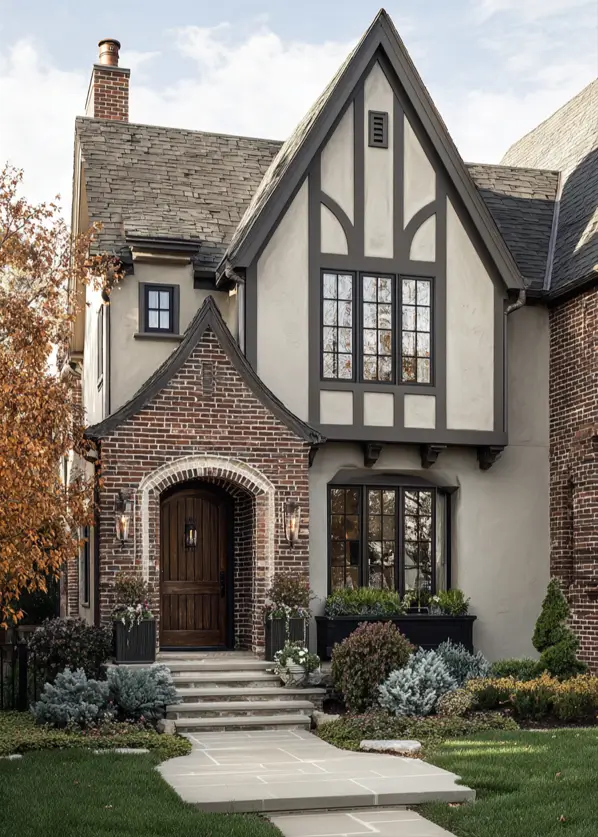
Covering the entryway with a brick-clad gable adds an inviting, sheltered transition into the home. This feature adds a layer of architectural depth, with the warm brick providing a pleasing contrast to the cooler tones of the main facade.
38. Combine Stone and Ivy
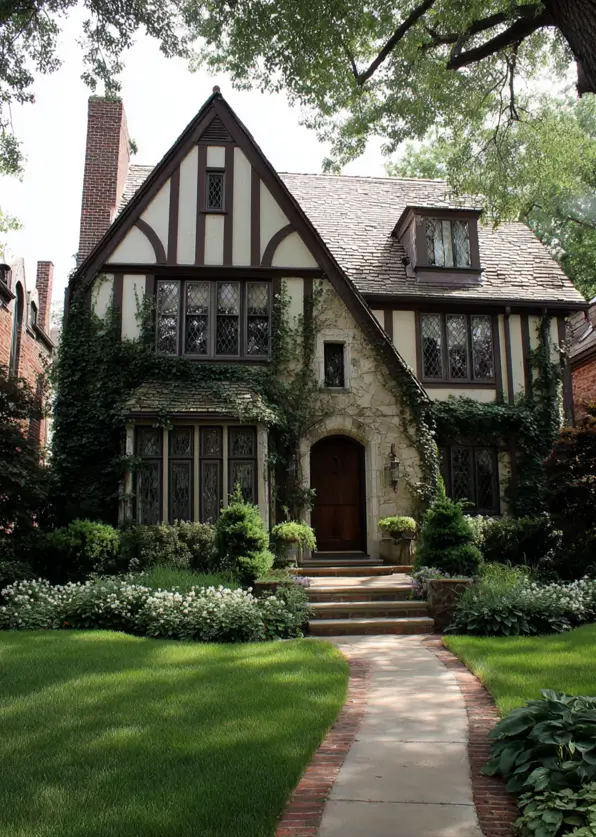
Natural stone grounds the lower portion of the home, providing a rustic and textured foundation. Above, classic stucco and half-timbering complete the iconic look, while climbing ivy weaves the elements together, adding a layer of organic beauty.
39. Cultivate a Cottage Garden
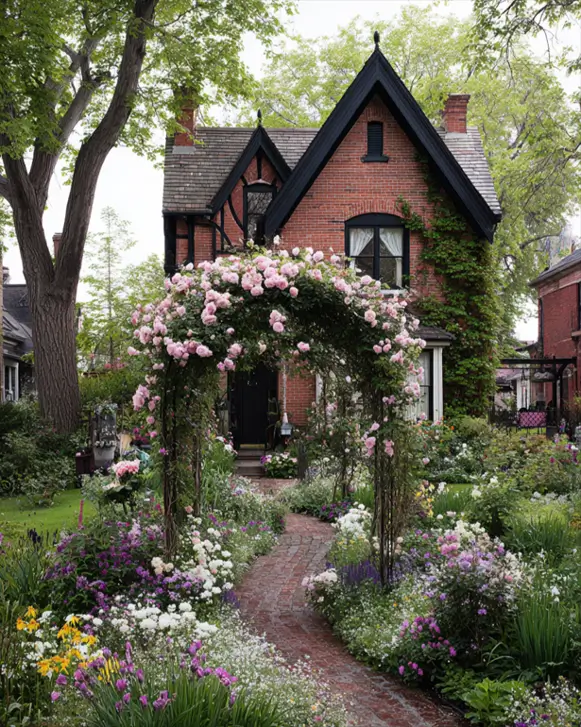
Lush cottage gardens create an utterly romantic setting, transforming a classic brick Tudor into a fairytale escape. A rose-covered arbor frames the winding brick path, inviting a stroll through blooms that beautifully soften the home’s architectural lines. You can learn how to cultivate a cottage garden to achieve this look.
40. Frame with Wooden Shutters
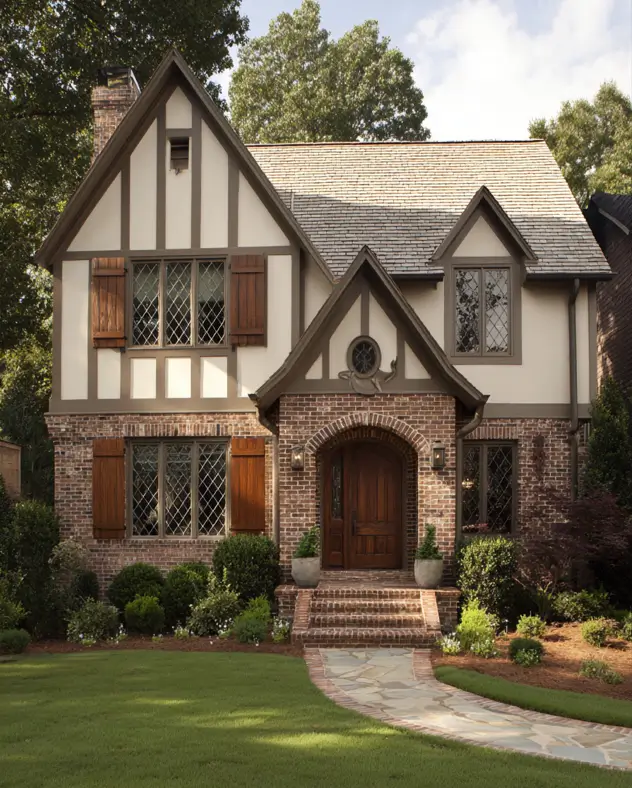
Rustic wooden shutters provide another layer of texture and character. Echoing the warm tones of the brick and timbering, they create a cohesive and detailed exterior, beautifully framing the intricate diamond-pane windows of the Tudor-style house exterior.
41. Elevate the Entrance
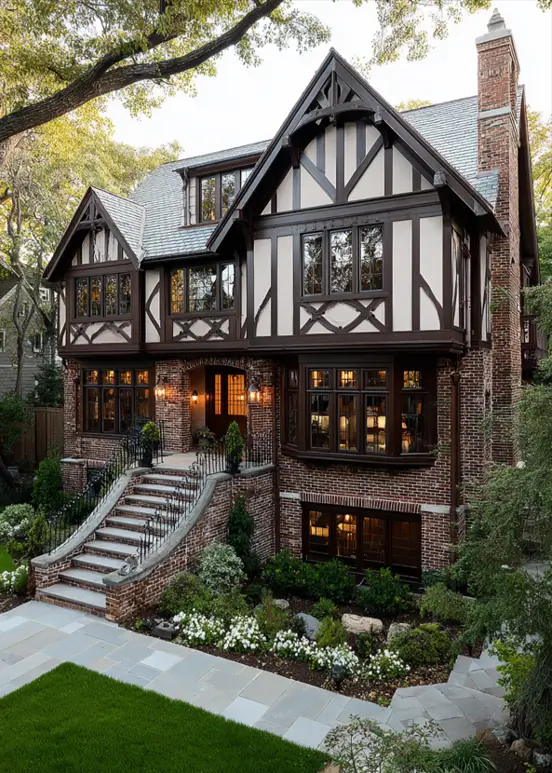
Working with a sloped property provides an opportunity for a grand, sweeping staircase. This home’s elevated entrance, crafted from brick, creates a formal approach that enhances its stately presence and overall curb appeal.
42. Create an Enchanting Glow
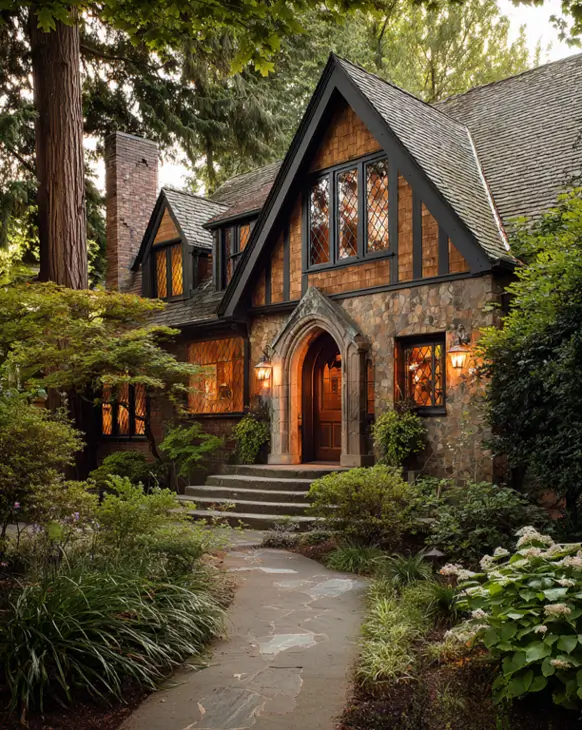
Warm light glowing from intricate windows creates an enchanting ambiance at dusk. The combination of rustic stone, wood shingles, and dark timber gives this home a storybook quality, making it feel like a magical retreat tucked away in the forest.
43. Frame with Abundant Roses
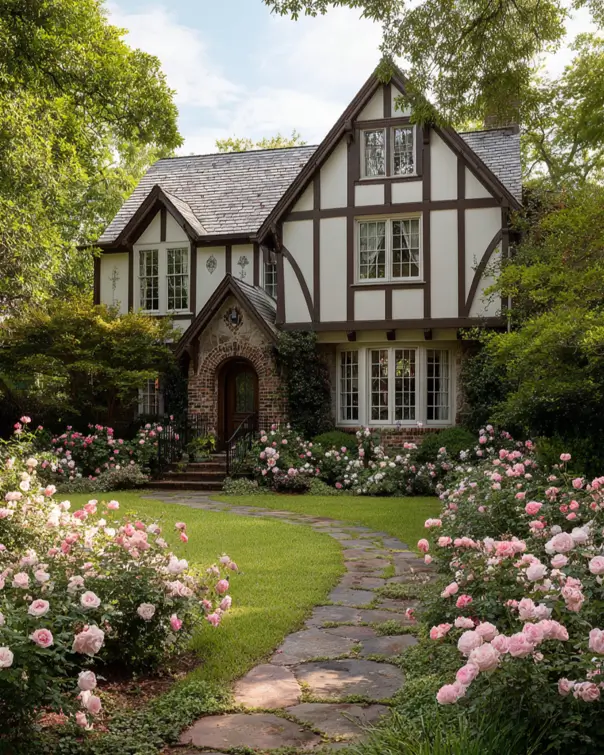
Abundant roses lining a flagstone path create an unforgettable welcome. This romantic landscaping softens the home’s formal architecture, inviting you into a classic storybook setting where the garden and the house exist in perfect, beautiful harmony.
44. Define with Stone
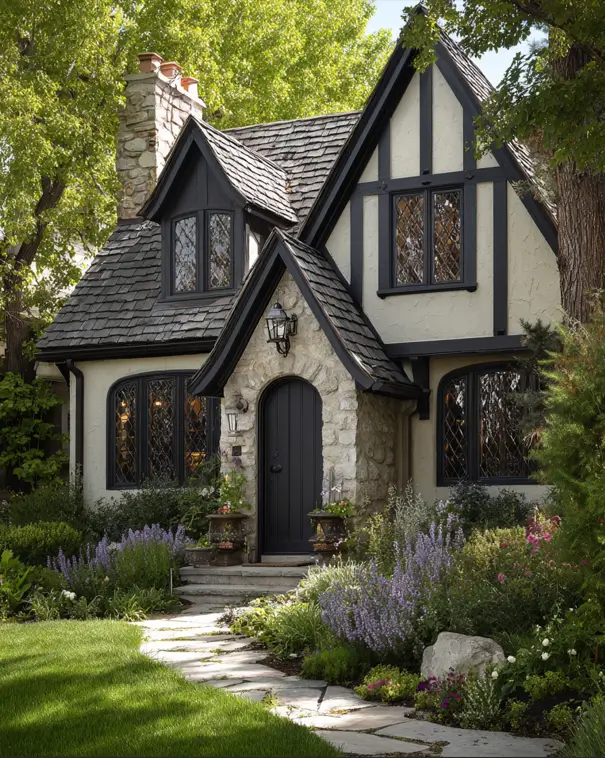
Stone creates a fortress-like, charming entrance for this compact cottage. The deeply set, arched door and classic half-timbering contribute to its storybook quality, an effect beautifully enhanced by the soft, romantic landscaping that frames the inviting flagstone path.
45. Add a European Feel
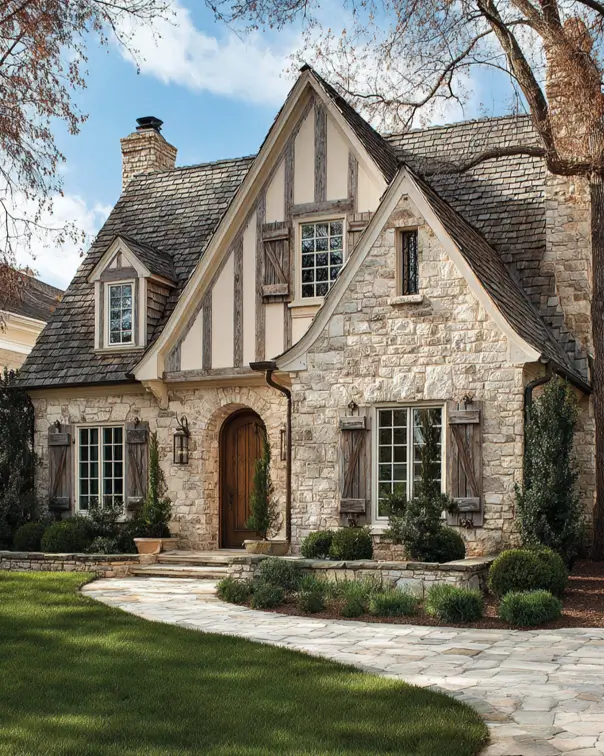
Warm, honey-toned stone gives this home a romantic, European countryside feel. The rustic wooden shutters and textured roof shingles add layers of authentic charm, while the gracefully curving flagstone path creates an inviting approach that complements the home’s pastoral aesthetic.
46. Blend into the Woods
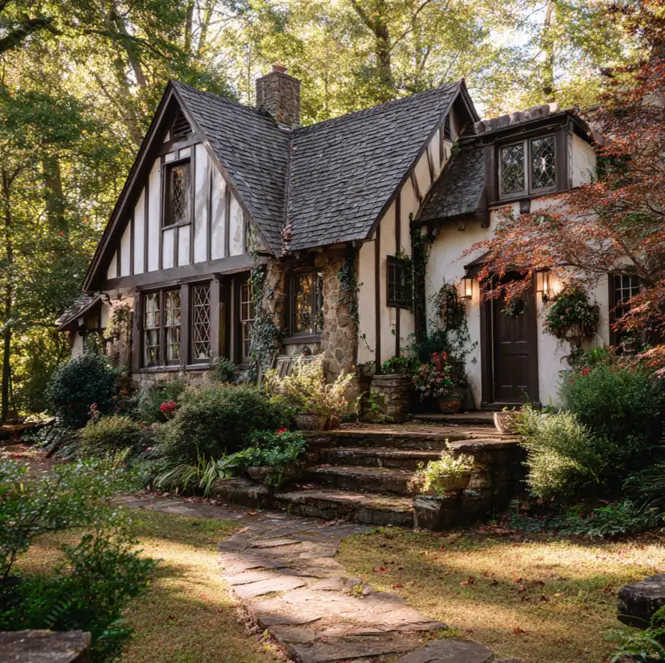
Deep, natural tones and rustic textures allow this home to blend seamlessly into its wooded surroundings. The combination of stone, stucco, and dark timbers creates an idyllic and peaceful retreat that feels entirely organic to the landscape.
Practical Considerations for Your Tudor Exterior Renovation
After gathering inspiration, it’s wise to consider the practical aspects of bringing your vision to life. A successful exterior renovation balances aesthetics with real-world factors like cost and maintenance.
Budgeting for Your Project
The cost of a Tudor-style exterior can vary significantly based on material choices. Natural stone and high-quality brick are premium materials that represent a significant investment, while traditional stucco is often a more budget-friendly option for large surfaces.
Similarly, the complexity of the decorative half-timbering can impact labor costs, so a simpler design may be more economical than an ornate one.
Choosing a Cohesive Exterior Color Scheme
A successful color scheme ties the entire facade together. For a classic look, stick to earthy tones—creams and beiges for stucco, with dark brown or black timbers. For a modern Tudor house exterior, a high-contrast palette of crisp white and black is a popular and striking choice.
A good rule of thumb is to consider fixed elements like your roof color, and then select a main field color, a trim color for timbers and eaves, and a distinct accent color for the front door.
A Final Thought on Tudor-Style Exterior Design
From classic Tudor Revival architecture to the clean lines of a modern Tudor-style house, this design offers a wealth of facade inspiration. The true success of any Tudor-style house exterior lies in the thoughtful balance of its architectural details. Whether planning an exterior renovation or a new build, the core principles of texture and contrast provide a timeless canvas for a truly memorable home.
Frequently Asked Questions
How can I create a modern Tudor house exterior?
To create a modern Tudor-style house, focus on simplifying the traditional form. Key strategies include using a high-contrast color palette (like black and white), choosing cleaner lines with less ornate timbering, installing larger windows with simple grids, and mixing contemporary materials with traditional ones. It’s about capturing the historic essence with a more minimal, graphic approach.
What are the best exterior colors for a Tudor-style house?
Classic Tudor homes favor earthy, natural palettes like cream or beige stucco with dark brown or black timbers. For a modern Tudor house exterior, crisp white with black trim is exceptionally popular. However, sophisticated grays, deep greens, or even bold blues on the timberwork can create a personal and stylish statement. The key is to establish a pleasing contrast between the timbers and the main facade.
What landscaping best complements a Tudor-style house exterior?
A Tudor-style house exterior is beautifully enhanced by lush, slightly informal landscaping. Classic choices include English cottage garden elements like climbing roses, lavender, and boxwood hedges. Structured, geometric hedges can emphasize the home’s architectural lines, while curving stone paths and abundant flower beds enhance its romantic, storybook quality.

